
 |
Philatelic History of Wilmington, North CarolinaRevised 11/26/2023 |
| (> 1859) Page 1 | (1860-1897) Page 2 | (1898-1916) Page 3 | (1917-1941) Page 4 | (1942-1971) Page 5 | (1972 >) Page 6 |
Philatelic Item |
It is our hope that this web-page will serve to stimulate an interest in the collecting, conservation and documentation of postal history covers of Wilmington.
Wilmington Philatelic Society |
|||
|---|---|---|---|---|
| Year | Pix | Cat # | Description | By |
| World War Two - On December 8, 1941, the day after Japan bombed Pearl Harbor, the US declared war on Japan. Three days later on December 11th Germany and Italy declared war on the US, forcing President Roosevelt to end America's official neutrality on the war then raging in Europe.
|
||||
| 1943 |
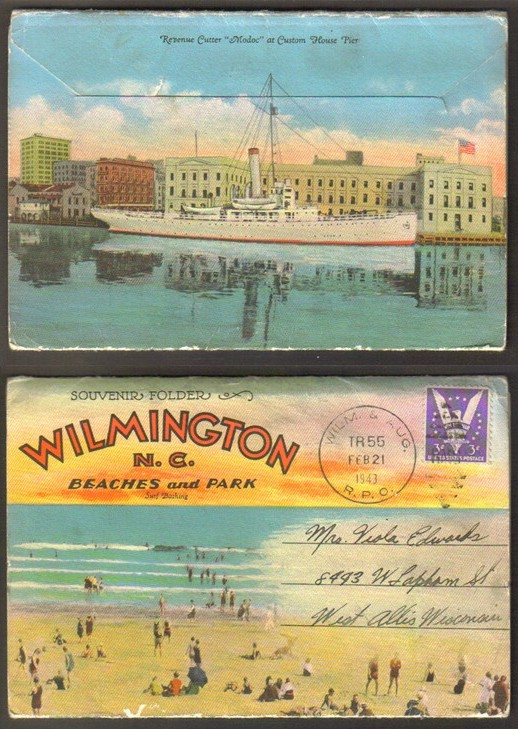
|
905 | A post card souvenir packet canceled on the Wilmington-Augusta GA Railroad (Railway Post Office ~ RPO) on February 21, 1943 and sent to West Allis WI.
History: After the Atlantic Coast Line (ACL) Railroad had subsumed Wilmington’s railroads, it set up its general offices and headquarters in Wilmington NC. By the early 1900's the ACL had constructed an extensive office and warehouse complex in Wilmington abutting the Cape Fear River at Red Cross and Front Streets. Amongst other commodities, the railroad brought cotton, naval stores and lumber for export from Wilmington’s port and transported imports of guano fertilizer supporting North Carolina’s agriculture. During WW-II ACL prospered transporting materials needed for the construction of ships in Wilmington. From Wilmington’s ACL’s headquarters, its composite railways and subsidiaries operated a network of transportation links. The Atlantic Coast Line Railroad headquarters moved from Wilmington NC to Jacksonville FL in 1961. ACL merged with Seaboard Air Line Railways in 1967 to form the Seaboard Coast Line. |
JJ |
| 1943 |
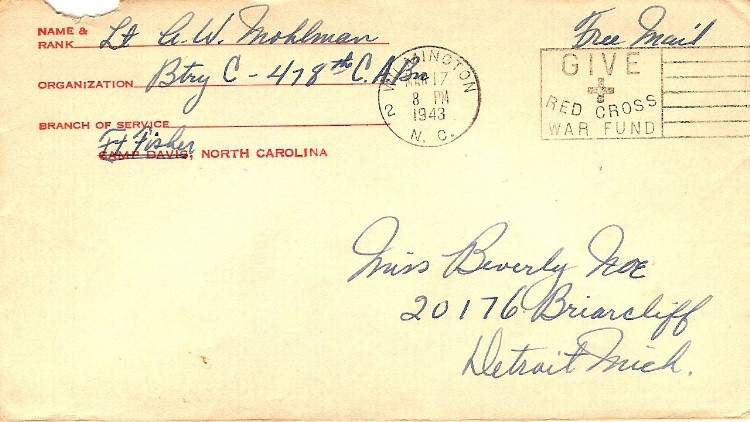
|
Free Flank |
A cover canceled on March 17, 1943 in Wilmington NC with a Fort Fisher return address. History: Fort Fisher was a Confederate fort during the American Civil War. It protected the vital trading routes of the port at Wilmington NC from 1861 until its capture by the Union in 1865. The fort was located on one of Cape Fear River's two outlets to the Atlantic Ocean on what is today known as Pleasure Island. In December 1940 (one year before the bombing of Pearl Harbor) construction began on a new military facility straddling Pender and Onslow counties at the village of Holly Ridge NC. This facility was named Camp Davis. By August 1941 Camp Davis covered over 9,000 acres and reached 20,000 troops to become one of the US Army's seven antiaircraft artillery training centers. The Camp resembled a city with its own government, courts, police force, utilities, churches, hospital, clinic, theaters, recreation centers and stores. For a brief period it had all three of the principal elements of coastal artillery under one command - antiaircraft, seacoast defense and barrage balloon training. As Camp Davis grew during WW-II, it expanded its operations to nearby Fort Fisher. Fort Fisher grew in importance to become the primary firing range for Camp Davis. New firing installations were erected along the beach between the highway and the Atlantic Ocean. These included batteries of 40-millimeter automatic cannons and 50-caliber machine guns and the construction of Fort Fisher Airstrip. The anti-aircraft training operations ceased at Fort Fisher in 1944. Today Fort Fisher is a tourist destination with the Fort Fisher Civil War Museum and the North Carolina Aquarium where visitors discover the amazing world of the sea. |
JJ |
| 1943 |
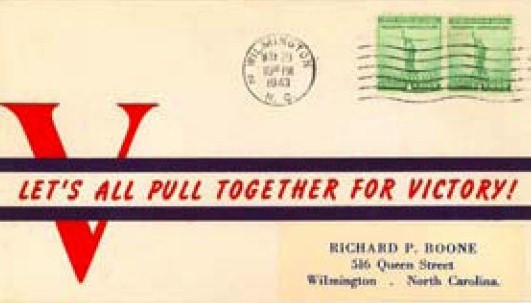
|
899x2 | A cover sent by Richard P Boone on May 29, 1943 from Wilmington NC to himself in Wilmington. History: The cachet on this patriotic cover was made by Wilmington's Richard P Boone. Boone published a series of cachets advocating America's "Victory" in WW-II and that "God Bless America" in America's pursuit to win the war. See below (1945) for a brief bio of Wilmington's Richard P Boone. 
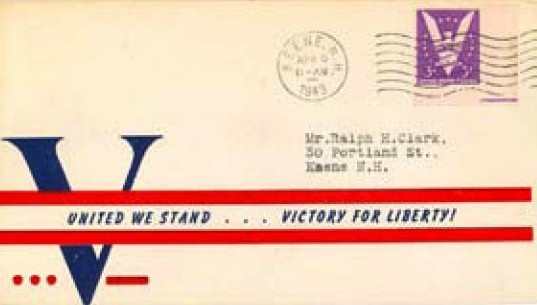
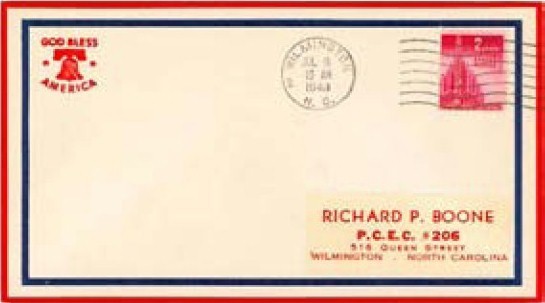
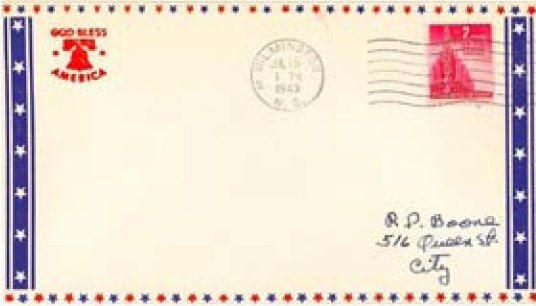
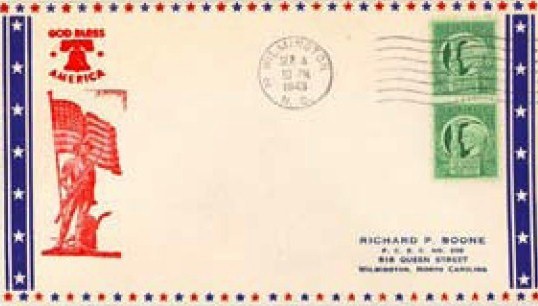
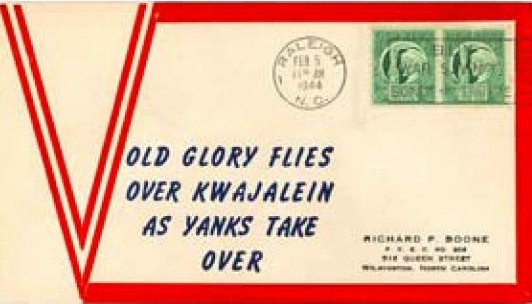
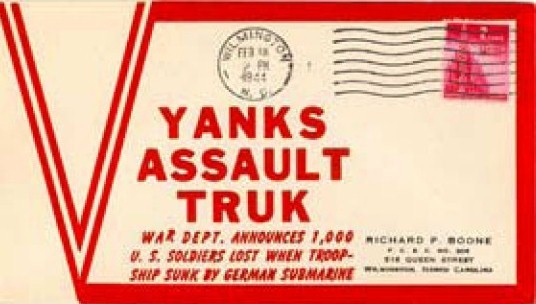
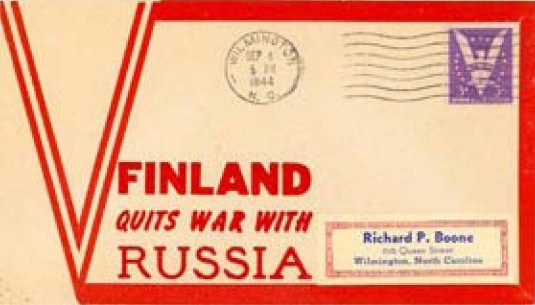
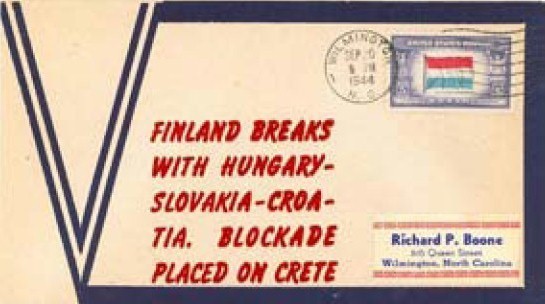
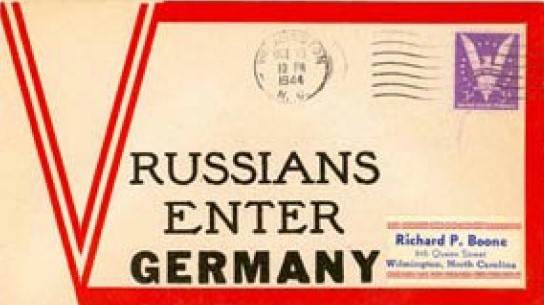
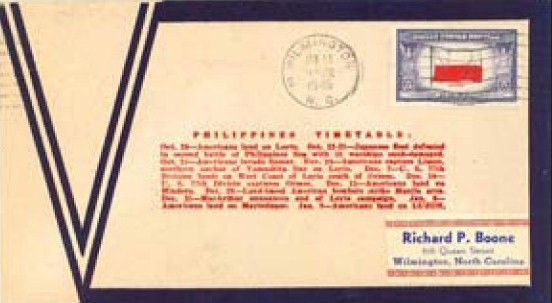
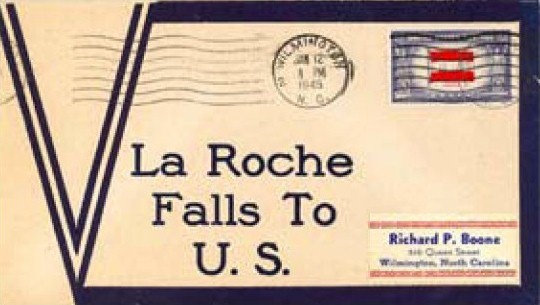
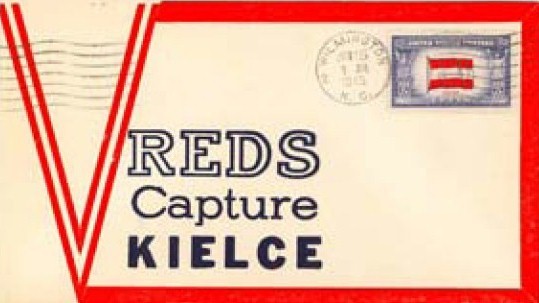
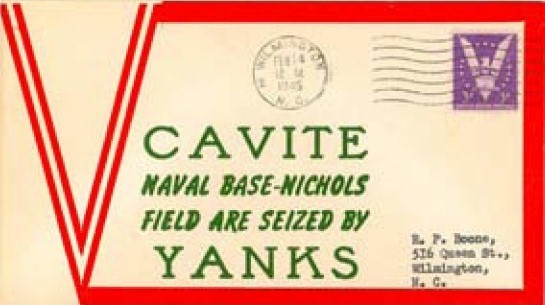
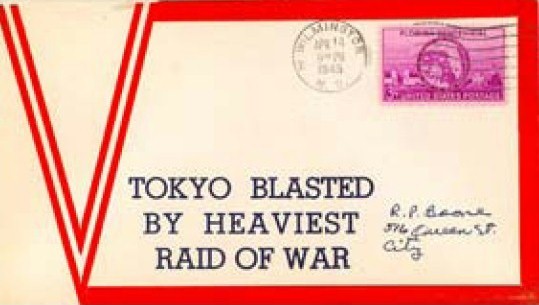
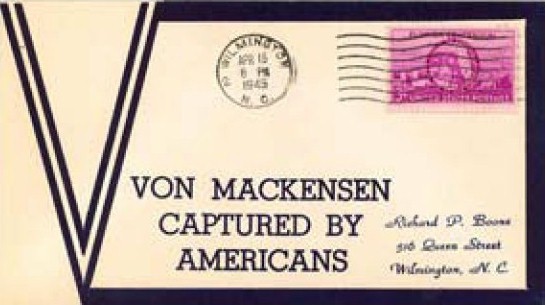
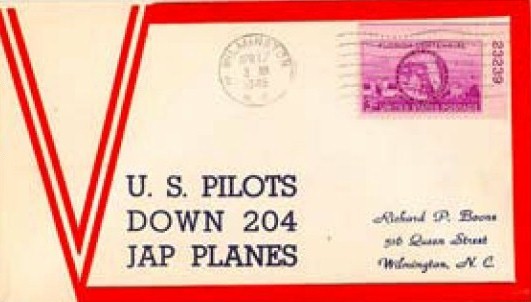
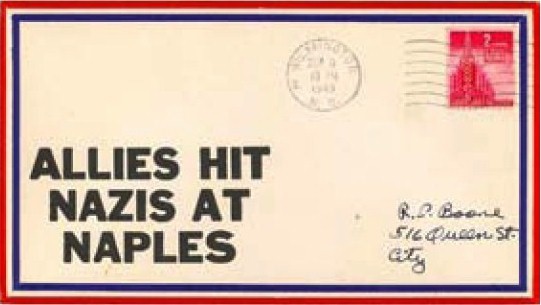
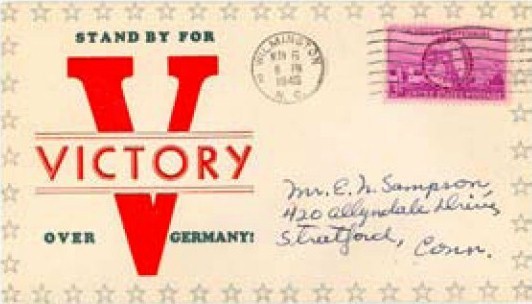
|
OO |
| 1943 |
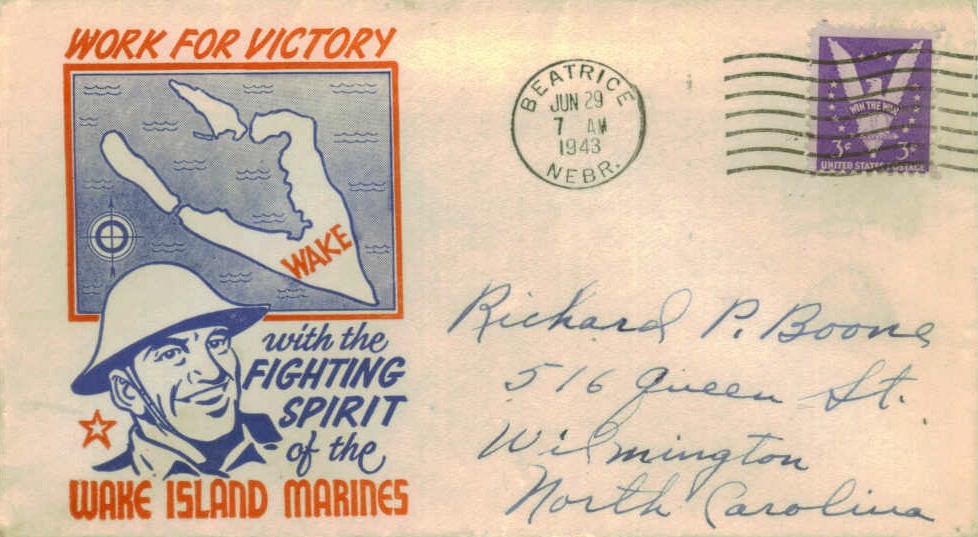
|
905 | A cover sent on June 29, 1943 from Beatrice NE addressed to cachet maker, Richard P Boone in Wilmington NC. History: The cachet on this patriotic cover was probably made by the Cachet Craft Cover Service/Frederick B Fitts at 32 Eden Street, Framingham MA. The cachet states, "Work for Victory with the fighting spirit of the Wake Island Marines." See below (1945) for a brief bio of Wilmington's Richard P Boone. |
RP |
| 1943 |
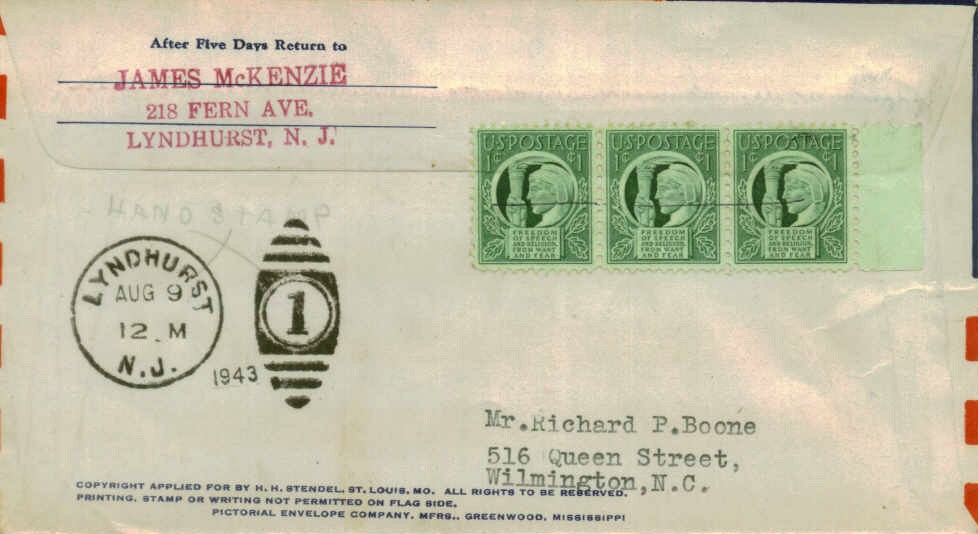
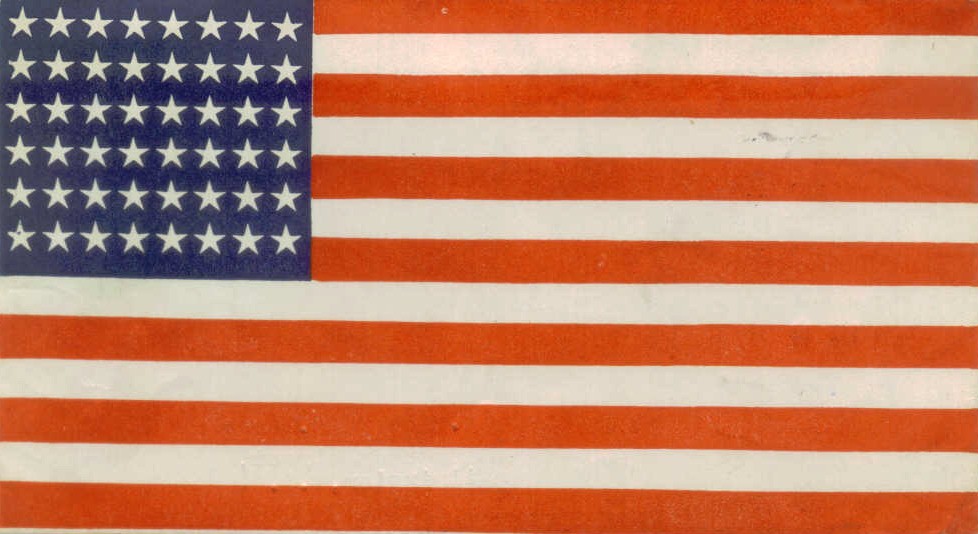
|
908x3 | A cover sent on August 9, 1943 from Lyndhurst NJ addressed to cachet maker, Richard P Boone in Wilmington NC. History: The cachet on this patriotic cover was made by HH Stendel Cachets in Saint Louis MO. Stendel applied for US copyright protection for his US flag cachet. He sought such protection to prevent defacing the flag with a stamp or writing on the flag side of the cover. See below (1945) for a brief bio of Wilmington's Richard P Boone. |
RP |
| 1943 |
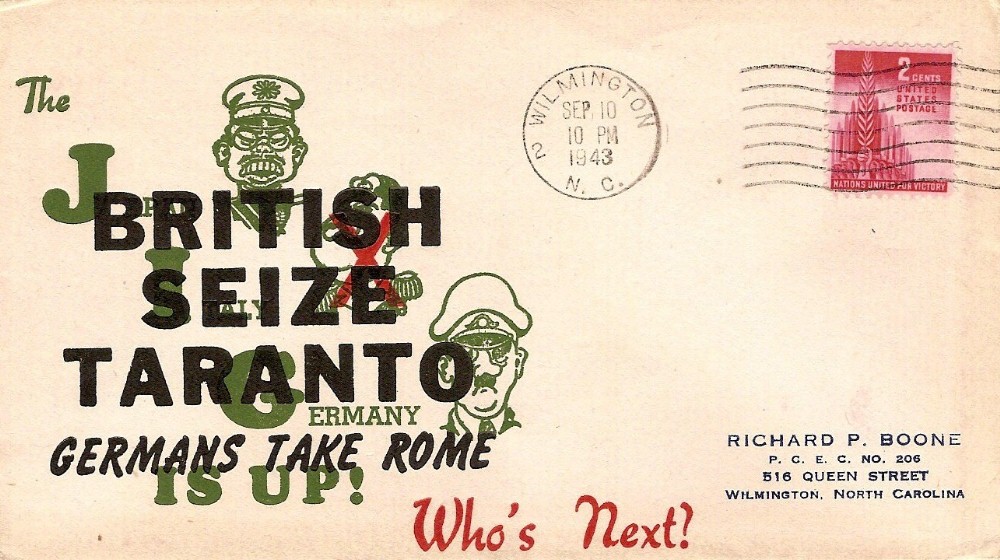
|
907 | A cover sent on September 10, 1943 from Wilmington NC addressed to cachet maker, Richard P Boone in Wilmington NC. History: The cachet on this patriotic cover was made by Wilmington's Richard P Boone. Boone published cachets all giving patriotic encouragement supporting US efforts in WW-II. On this cachet, Boone stated, "British Seize Taranto" See below (1945) for a brief bio of Wilmington's Richard P Boone. |
RP |
| 1943 |
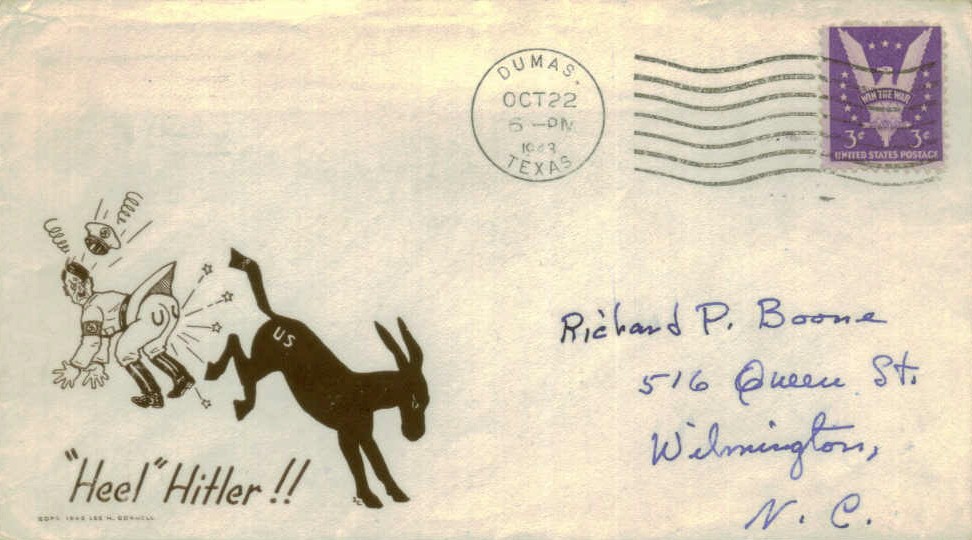
|
905 | A cover sent on October 22, 1943 from Dumas TX addressed to cachet maker, Richard P Boone in Wilmington NC. History: The cachet on this patriotic cover was made by Lee H Cornell of Wichita KA. See below (1945) for a brief bio of Wilmington's Richard P Boone. |
RP |
| 1943 |
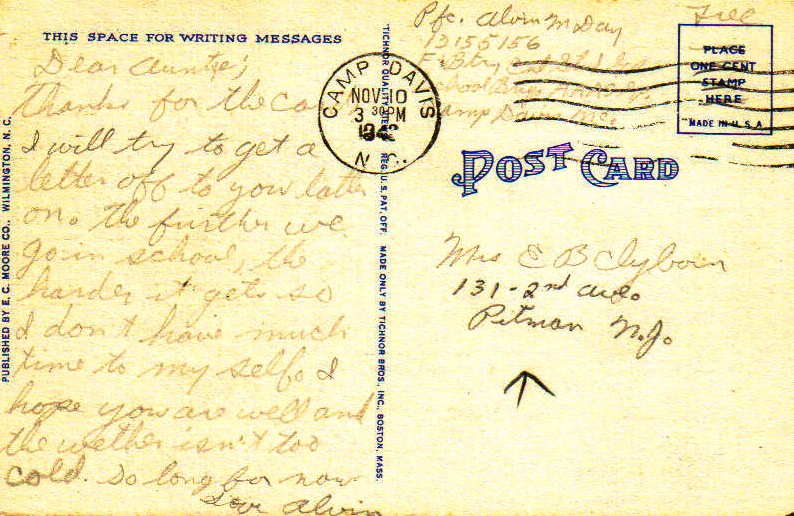
|
Free | A soldier's mail post card sent on November 10, 1943 from Camp Davis NC, a short 30 miles northeast of Wilmington. History: In December 1940 (one year before the bombing of Pearl Harbor) construction began on a new military facility straddling Pender and Onslow counties at the village of Holly Ridge NC. This facility was named Camp Davis. By August 1941 Camp Davis covered over 9,000 acres and reached 20,000 troops to become one of the US Army's seven antiaircraft artillery training centers. The Camp resembled a city with its own government, courts, police force, utilities, churches, hospital, clinic, theaters, recreation centers and stores. For a brief period it had all three of the principal elements of coastal artillery under one command - antiaircraft, seacoast defense and barrage balloon training. WW-II transformed nearby Wilmington into a boomtown and its population soared as its businesses flourished. Camp Davis and its satellite artillery ranges closed in October 1944, with nearly one year of war yet to be waged in both the Japanese and German theaters of conflict. Camp Davis would live in every shot fired at Axis planes, live in the high morale and combat efficiency of its trained troops and live in the hearts of all WW-II antiaircraft artillerymen and women. |
JJ |
| 1943 |
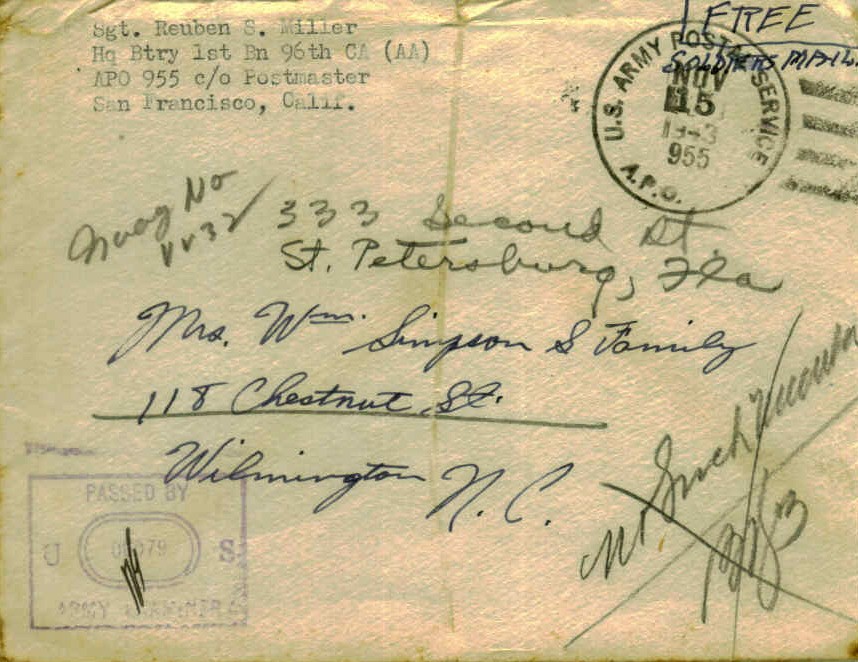
|
Free | A soldier's mail cover canceled on November 15, 1943 sent from US Army APO 955 to Wilmington NC. Soldier's Mail during WW-II had the privilage of being sent without postage (Free Flanking). History: From Sergeant Reuben S Miller Headquarters Battery 1st Battalion 96th Coastal Artillery (Anti-Aircraft) Army Post Office 955 (Camp Malakole, Oahu, Hawaii) Free Flanking Soldier's Mail Passed by US Army Examiner |
RP |
| 1944 |
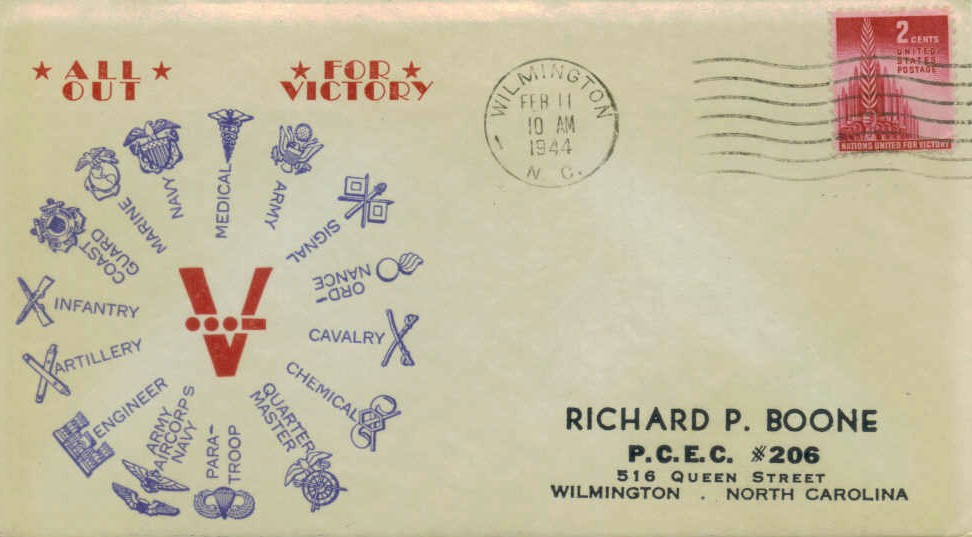
|
907 | A cover sent on February 11, 1944 from Wilmington NC to cachet maker, Richard P Boone in Wilmington NC. History: The cachet on this patriotic cover was made by Michael Sanders in New York City. It depicts the various components of the US military and states, "All Out For Victory." See below (1945) for a brief bio of Wilmington's Richard P Boone. |
RP |
| 1944 |
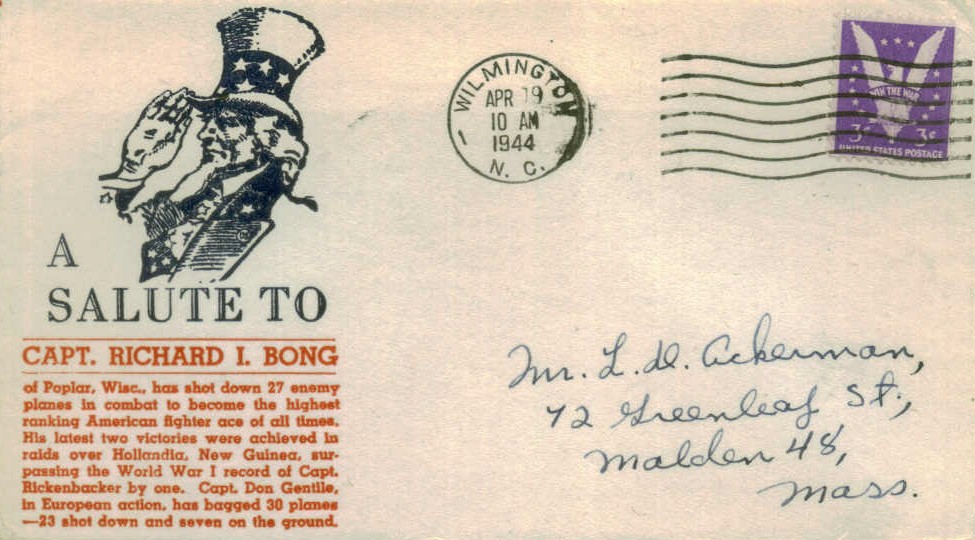
|
905 | A cover sent by Richard P Boone on April 19, 1944 from Wilmington NC to Malden MA. History: The cachet on this patriotic cover was made by Wilmington's Richard P Boone. Boone published a series of cachets all giving "Salute" to notable US people supporting our efforts in WW-II. See below (1945) for a brief bio of Wilmington's Richard P Boone. 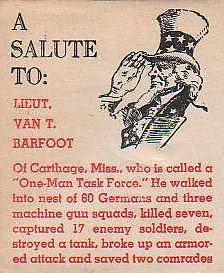
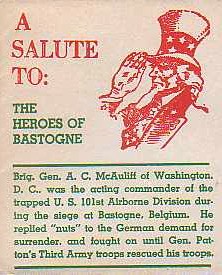
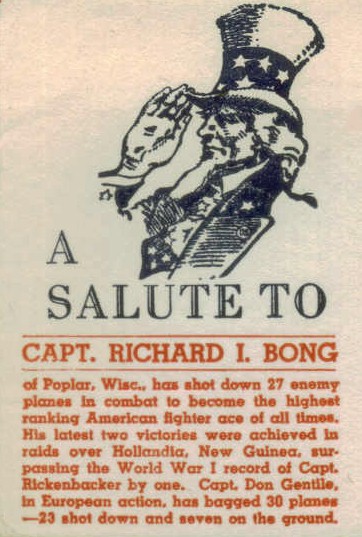
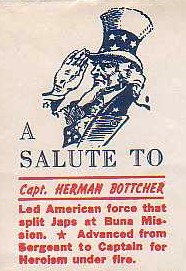
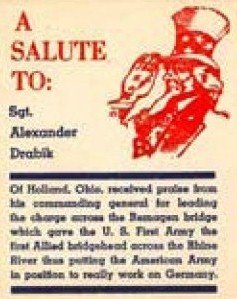
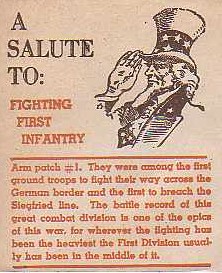
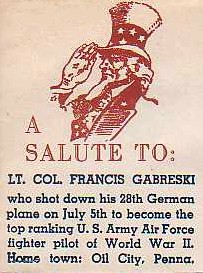
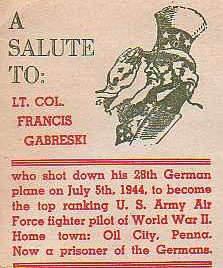
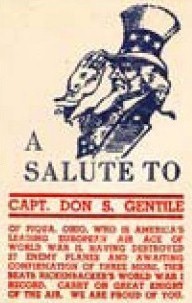
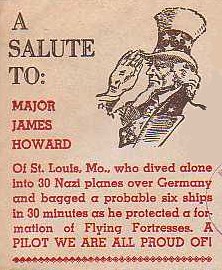
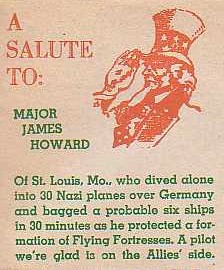
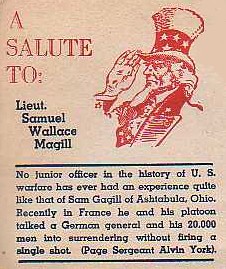
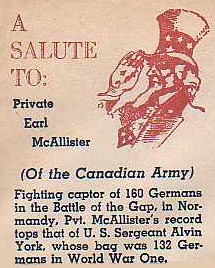
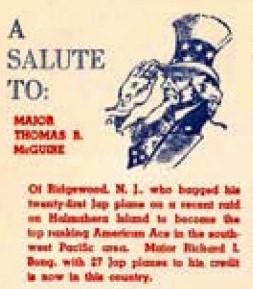
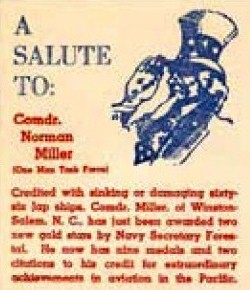
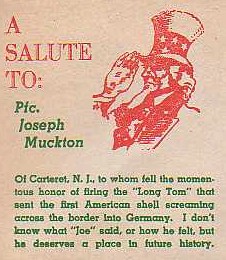
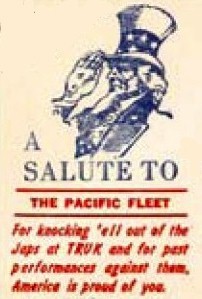
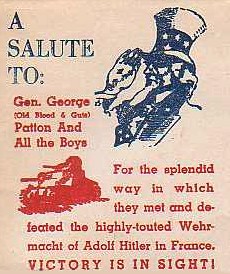
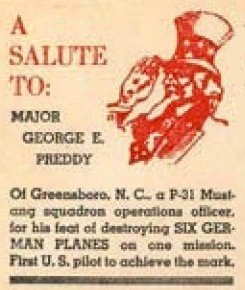
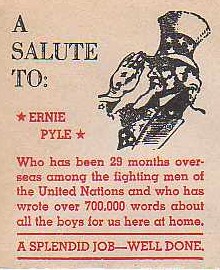
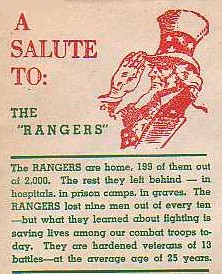
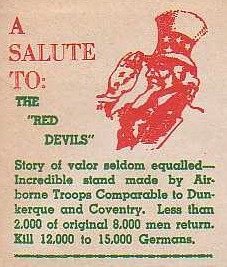
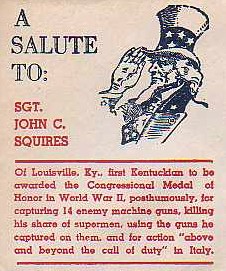
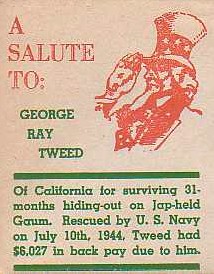
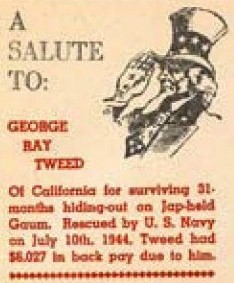
|
RP |
| 1944 |
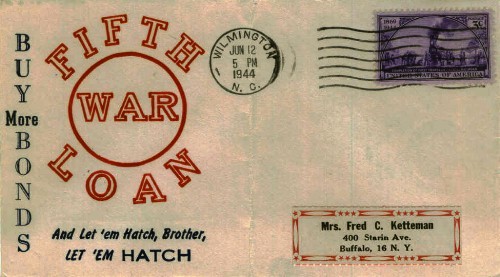
|
922 | A cover sent on June 12, 1944 from Wilmington to Buffalo NY advocating "Buy (More) Bonds" supporting the Fifth War Loan. History: To assist in the financing of WW-II, President Franklin D. Roosevelt spearheaded the sale of war bonds to Americans. By doing so it stirred the conscience of Americans involving both their financial and moral stake in the war. By buying war bonds, the home-front contributed to the national defense and war effort. While the initial goal of the war bond campaign was to finance the war, the positive impact on the morale of home-front Americans was its greatest accomplishment. The First War Loan began on November 30, 1942 and ended December 23, 1942 with bond sales totaling almost $13 billion. On April 12, 1943 the Treasury launched the Second War Bond Drive. Upon its completion on May 1, 1943 over $18.5 billion had been invested in the war effort. President Roosevelt gave a rousing address on the evening of September 8, 1943 to start the Third War Bond Drive. Kate Smith raised $39 million through a telecast on CBS. Over 152,000 advertisements placed in newspapers to promote this drive between September 9, 1943 and its close on October 2, 1943 represented only a fraction of the estimated $23.4 million worth of donated advertising. The Fourth War Bond Drive began on January 18, 1944 and ended almost a month later on February 15, 1944. It largely targeted farmers and women selling 70 million separate E- Bonds raising $16.7 billion dollars. June 12, 1944 marked the beginning of the most ambitious war financing campaign. The Fifth War Loan was the largest of the eight drives and by its conclusion on July 8, 1944 $20.6 billion in bonds had been sold. The Sixth, Seventh and Eighth War Bond Drives continued through December 8, 1945. |
TB |
| 1944 |
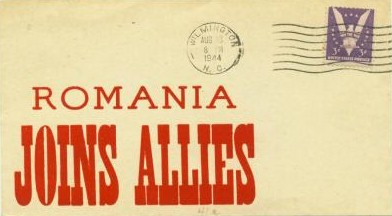 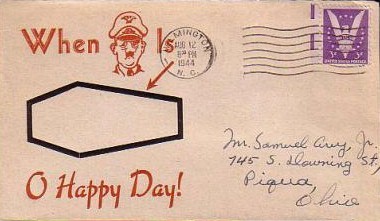
|
905 | Patriotic covers canceled in August 1944 in Wilmington trumpeting "WIN the WAR" with special American Eagle, Win the War stamp. History: WW-II notable dates .......... 09/01/39 ---- Nazis invade Poland 09/03/39 ---- Britain, France, Australia & New Zealand declare war on Germany 04/09/40 ---- Nazis invade Denmark and Norway 05/15/40 ---- Holland surrenders to the Nazis 11/15/40 ---- Nazis bomb Coventry, England 12/07/41 ---- Japan attacks Pearl Harbor & US enters WW-II 12/11/41 ---- Germany declares war on the United States 08/17/42 ---- First all-American air attack in Europe |
OO |
| 1944 |
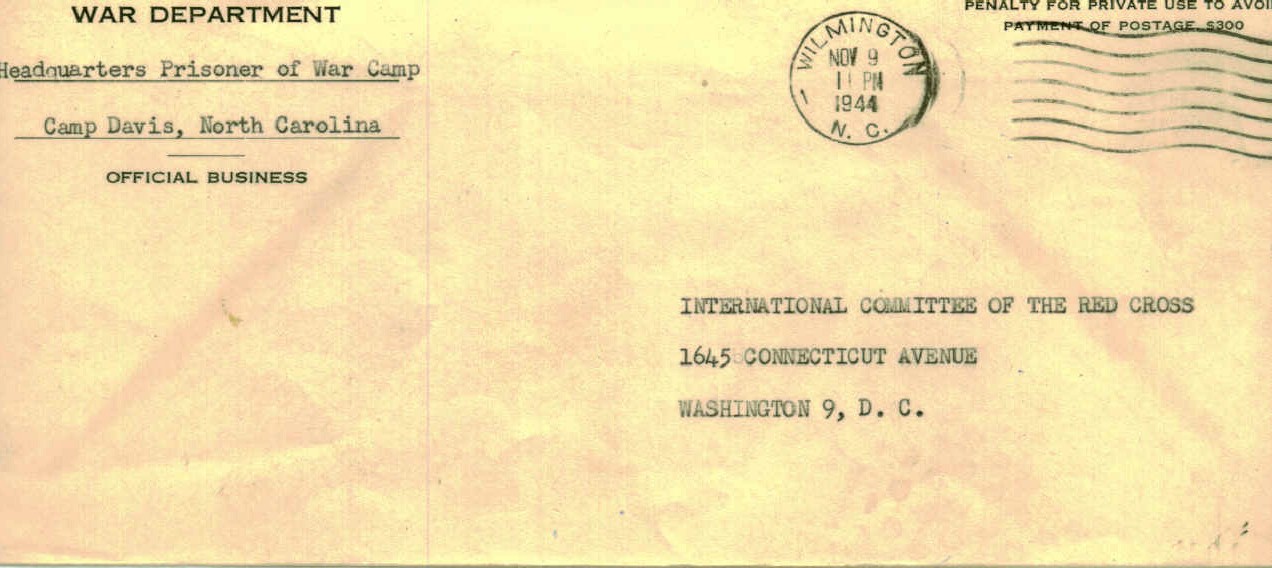
|
--- | A cover sent on November 9, 1944 from the POW Camp in Wilmington to the International Red Cross in Washington DC. History: As WW-II progressed it was necessary to intern captured enemy soldiers. North Carolina received its first group of POWs when German sailors were rescued from U-boat 352, which sank off the Carolina coast on May 9, 1942. They were confined at Fort Bragg but the need for additional internment facilities caused the US War Department to set up seventeen POW camps across North Carolina. One of these POW camps as part of Camp Davis was established in Wilmington on February 1944 on the southeast corner of Shipyard Boulevard and Carolina Beach Road. A commemorative marker stands on this site. A second POW camp was opened in October 1944 between 8th and 10th Streets from Castle to Ann Street and a third was at the Wilmington Airport. |
RP |
| 1944 |
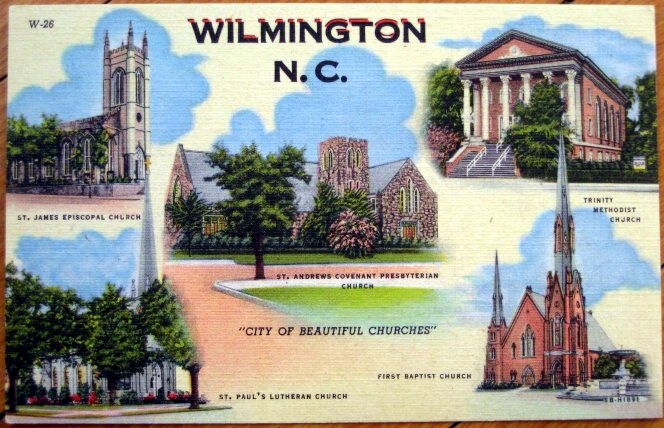
|
--- | A post card (circa 1944) of the Trinity Methodist
Church and other beautiful churches in Wilmington. History: Trinity Church began in 1889 when a few members of Grace Methodist Church and Fifth Street Methodist Church met to organize a Sunday School in the eastern section of Wilmington. On May 28, 1891, the Market Street Methodist Episcopal Church, South was officially organized. Church members bought a lot on the northeast corner of Ninth and Market Streets in 1894. Five years later on May 28, 1899 the new church was dedicated as the Market Street Methodist Episcopal Church, South. In 1906 the name of the church was changed to Trinity Methodist Episcopal Church, South. Another lot was purchased at 14th and Market Streets and in 1916 construction of a new neoclassical revival style church building was begun but was delayed until after the end of WW-I. The first worship service in the new building was held on December 4, 1921. In 1934 the denomination changed its name to Trinity Methodist Church. |
OO |
| 1944 |
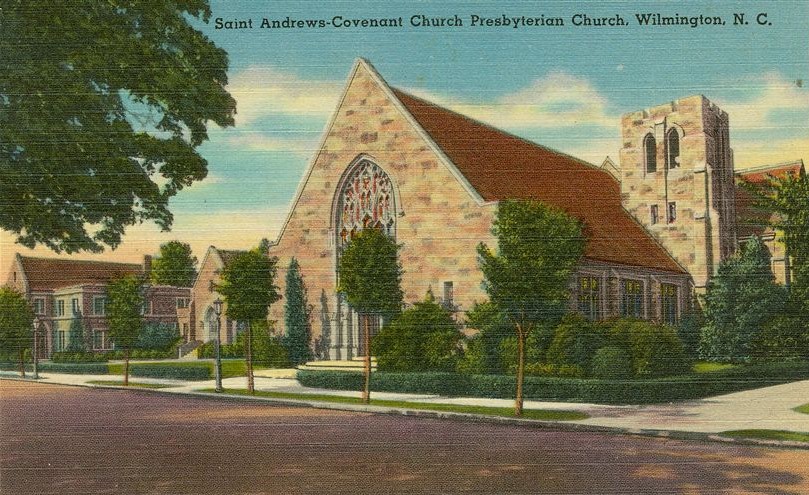
|
--- | A post card (circa 1944) of the Saint Andrews-Covenant Presbyterian Church. History: Saint Andrews Presbyterian Church was established in 1858 as the Second Presbyterian Church, a colony from the First Presbyterian Church. Thirty years later in 1888, the church was renamed Saint Andrews Presbyterian Church. In 1911 the Church of the Covenant purchased a lot on the corner of 15th and Market Streets. In 1944 Saint Andrews Church and the Church of the Covenant merged. Over the years dreams became reality as Saint Andrews-Covenant Church grew along with its congregation, services and facilities. |
OO |
| 1945 |
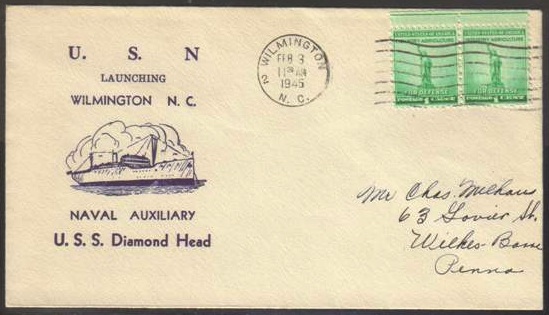
|
899x2 | A cover sent on February 3, 1945 from Wilmington NC commemorating the Wilmington launching of the USS Diamond Head (AE-19). The Diamond Head was the 200th ship (of 243 ships) built in Wilmington. It was the next to the last ship built for the Navy. History: Under a Maritime Commission contract, the USS Diamond Head was launched on February 3, 1945 by the North Carolina Shipbuilding Company in Wilmington NC. This ship was sponsored by Mrs D Bill and was transferred to the Navy on March 10, 1945. She was later converted at the Bethlehem Key Highway Shipyard in Baltimore MD and commissioned August 9, 1945 under the command of Lieutenant Commander FC Snow, USNR. She arrived at Norfolk VA for duty in the Atlantic Service Force on September 20, 1945 and after training, was used experimentally by the Bureau of Ships to test suitable markings for hospital ships. With the end of WW-II, she departed Norfolk VA on April 5, 1946 for Galveston TX where she was “placed in reserve out of commission” on August 23, 1946. The Diamond Head was recommissioned on August 9, 1951 as part of the naval expansion in support of the Korean War. She was reassigned to the Atlantic Fleet as an ammunition ship taking her place as part of the vital logistics support force that gave the United States Navy outstanding sea-keeping abilities and unprecedented mobility. She then served in various operations along the east coast and in the Caribbean through 1960 making five cruises with the 6th Fleet in the Mediterranean. On March 16,1967 the Diamond Head left Norfolk VA for a 9 month deployment in Vietnam. She carried ammunition rearming close to 200 ships transferring almost 12,000 tons of ammunition. She returned to Norfolk VA on December 19, 1967, was struck from the Naval Register on March 1, 1973 and sold for scrap in 1974. |
JJ |
| 1945 |
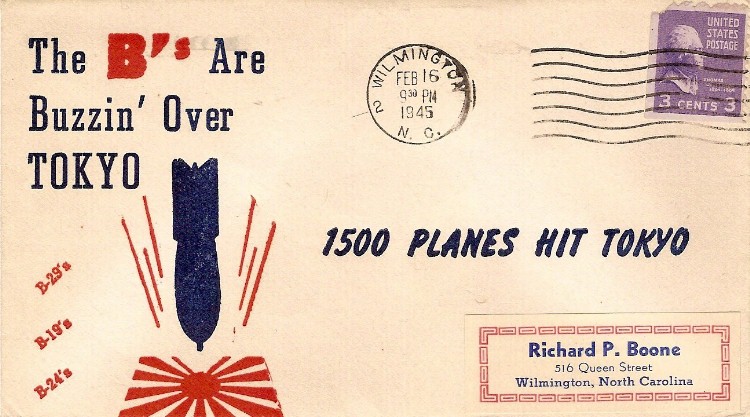
|
807 | A cover sent by Richard P Boone on February 16, 1945 from Wilmington NC to Wilmington NC. History: The cachet on this patriotic cover was made by Wilmington's Richard P Boone. Boone published cachets all giving patriotic encouragement supporting US efforts in WW-II. On this cachet, Boone stated, "The B's Are Buzzin' Over Tokyo" - B-29's, B-19's & B-24's - 1500 Planes Hit Tokyo." See below (1945) for a brief bio of Wilmington's Richard P Boone. |
RP |
| VE Day - "Victory in Europe" after the surrender of Germany on May 8, 1945.
|
||||
| 1945 |
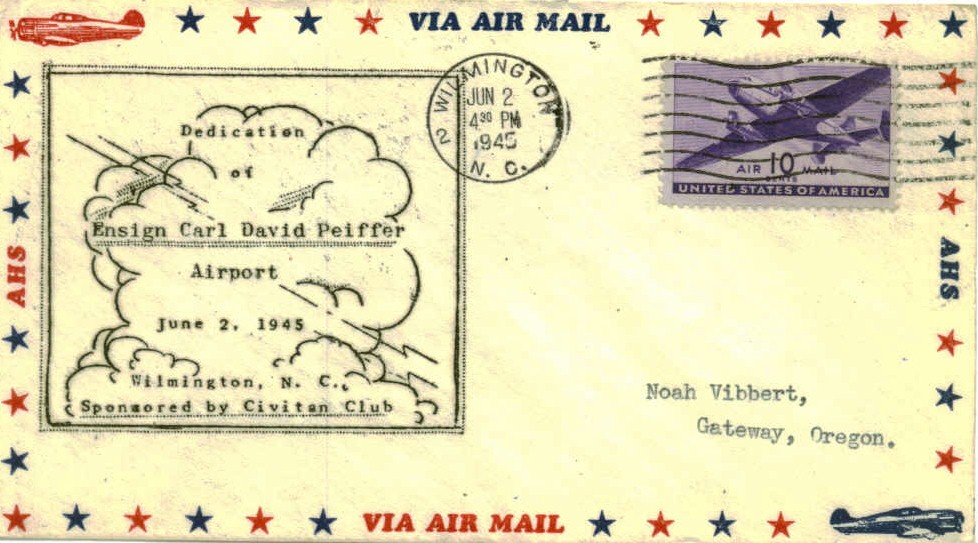
|
C-27 | An airmail cover sent on June 2, 1945 from Wilmington to Gateway OR. The cover commemorates the dedication of the opening of the Ensign Carl David Peiffer Airport in Wilmington. The cover was sponsored by the Wilmington Civilian Club. History: Ensign Peiffer was a WW-II hero from the Wilmington area. He was killed on June 5, 1942 in the Battle of Midway. After graduating from New Hanover Highschool, Peiffer attended the University of North Carolina where he graduated in 1940. John A Colucci together with William DeCover and JP Wilson formed Carolina Skyways. They rented and sold aircraft, provided air charters and flight training instruction from their headquarters at Peiffer Airport. Peiffer Airport was located on a 40 acre tract of land off of Oleander one mile west of Seagate. It had two grass runways, one 1,800 feet and the other, 2,000 feet long. Peiffer ceased operations in 1948 and the land was quickly developed. |
RP |
| 1945 |
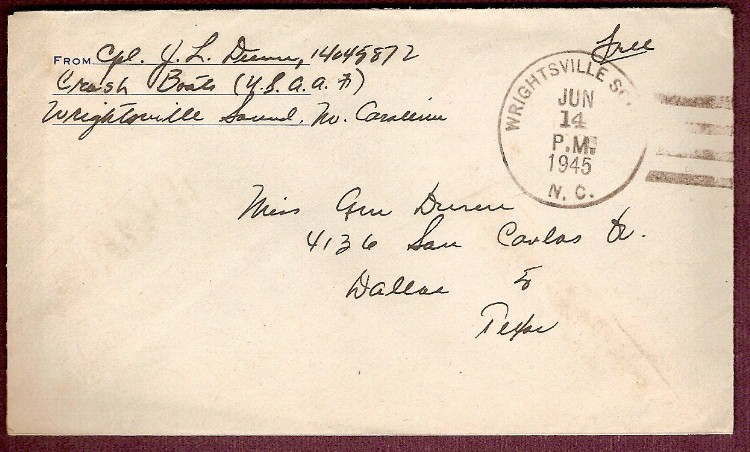
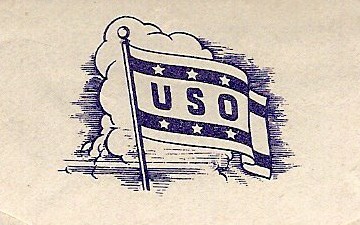
|
Free | A cover sent on June 14, 1945 from Wrightsville Sound, Wilmington to Dallas TX by Captain JL Dunn USAAF (Crash Boats). The envelope was supplied by the local Wilmington USO (United Service Organizations).
History: The United States Army Air Forces (USAAF) was the military aviation arm of the United States during and immediately after WW-II. The USAAF had crash boats that were used to rescue air crews along the coast of the US where a lot of flying and training took place. |
RP |
| 1945 |
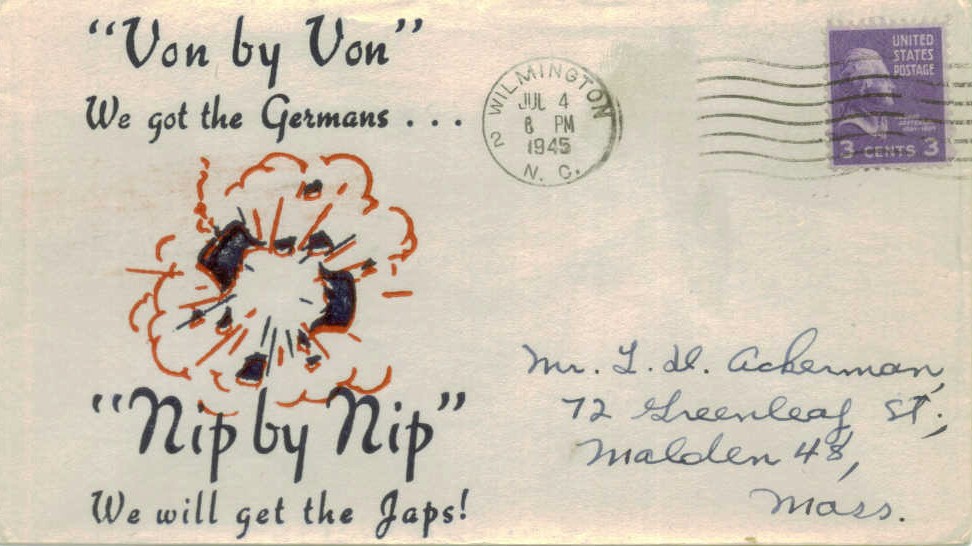
|
807 | A cover sent by Richard P Boone on July 4, 1945 from Wilmington NC to Malden MA. History: The cachet on this patriotic cover was made by Wilmington's Richard P Boone. Boone published cachets all giving patriotic encouragement supporting US efforts in WW-II. On this cachet, Boone stated, "VON by VON - We got the Germans" and "NIP by NIP - We will get the Japs." See below (1945) for a brief bio of Wilmington's Richard P Boone. |
RP |
| 1945 |
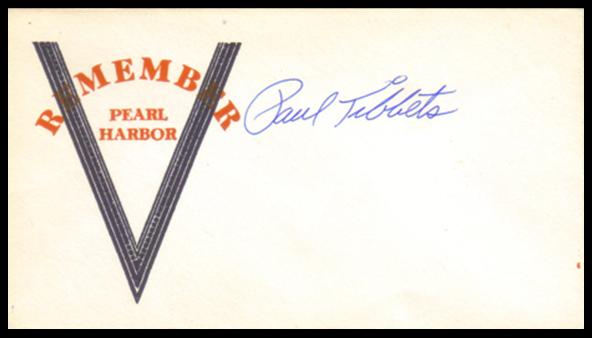
|
807 | An uncancelled cover with a special "Remember Pearl Harbor" Richard Boone patriotic cachet that has been autographed by Paul Tibbets. Tibbets piloted the Enola Gay B-29 that dropped the atom bomb on Hiroshima Japan. Richard Boone was a resident of Wilmington NC. History: The US dropped two atomic bombs on the Japanese cities of Hiroshima and Nagasaki to end WW-II. The nuclear weapon “Little Boy” was dropped from the Enola Gay B-29 on Hiroshima on August 6, 1945. It was piloted by commander, Colonel Paul Tibbets. Three days later on August 9th the nuclear weapon, “Fat Man” was dropped from the Bockscar B-29 on Nagasaki. It was piloted by commander, Major Charles W Sweeney. |
JJ |
| 1945 |
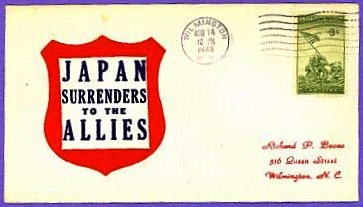
|
929 | A cover canceled in Wilmington NC on August 14, 1945 commemorating the surrender of Japan. This cover contains a patriotic cachet by Richard P Boone. History: Richard P Boone was a printer in Wilmington NC. He produced more than 500 different patriotic covers during WW-II. In 1944 Linn's Weekly Stamp News noted that "his (Boone's) covers are all printed (lithographed) by himself, the editions are never very large and thus all of them will be scarce in the future." Richard Boone had served in the Navy on PCEC #206 (Patrol Craft Escort Coastal) and resided on Queen Street in Wilmington NC with his wife, Pearl. All of his cachets centered around patriotic themes to "Win the War." Boone was a linotype operator employed by the "Wilmington Stamp and Printing Company." They had their offices at 211-13 North 2nd Street where they provided printing, ruling, binding, multigraphing, mimeographing, engraving and embossing services. The president of Wilmington Stamp & Printing was Fred E Little and the vice-president was Harry Wettig. 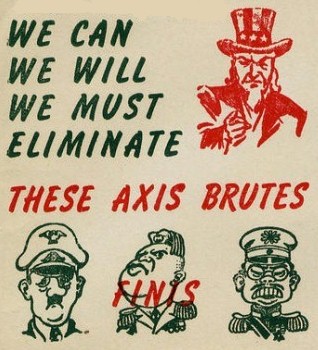
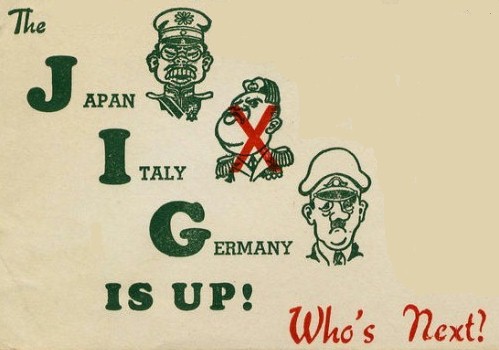
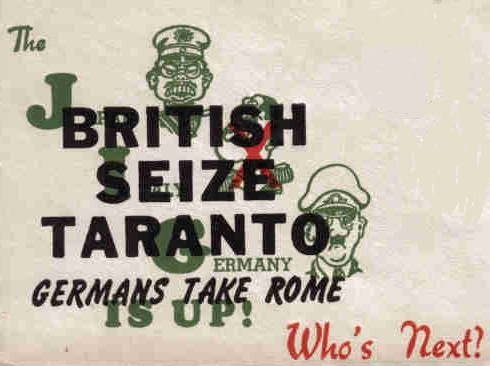

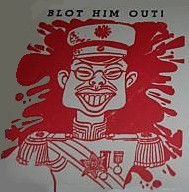
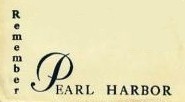
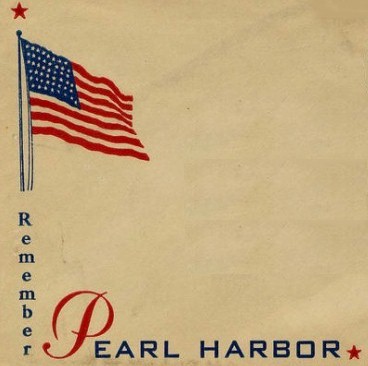
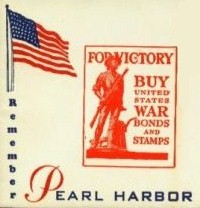
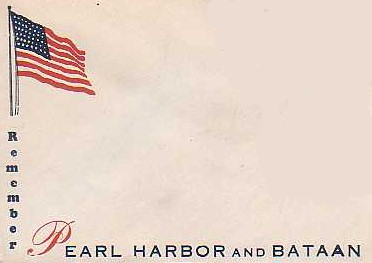
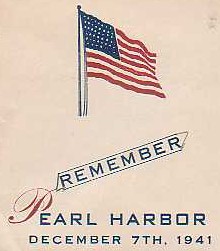
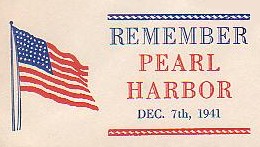
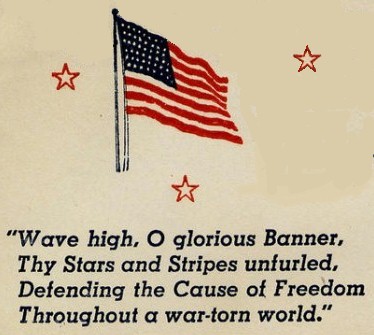
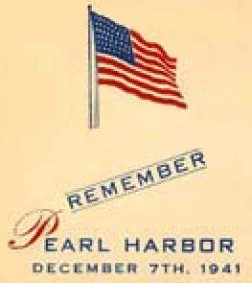
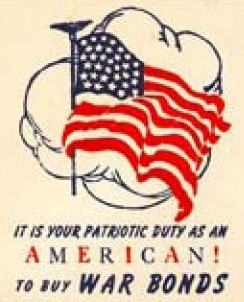
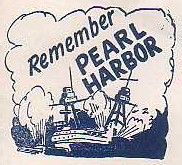
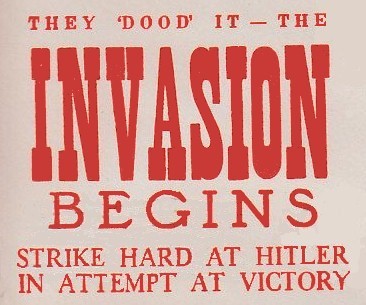
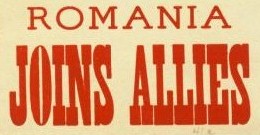
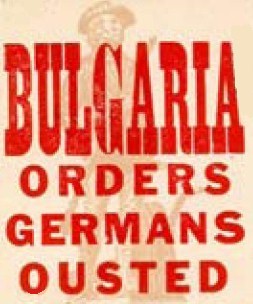
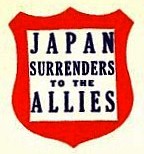
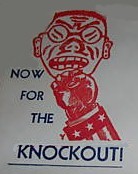
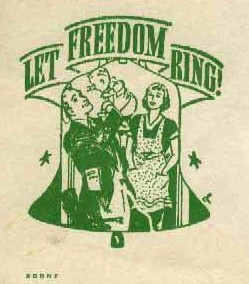
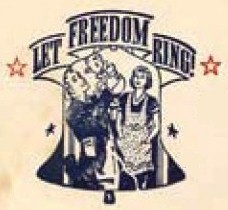
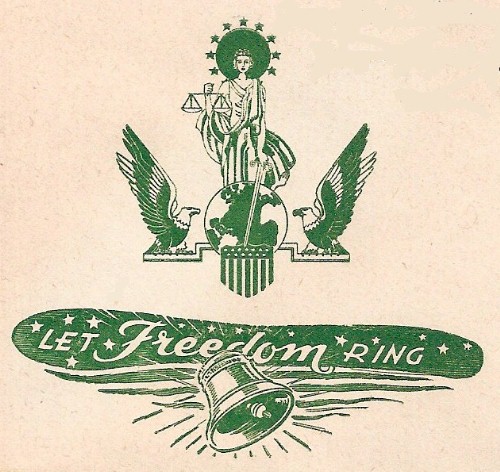
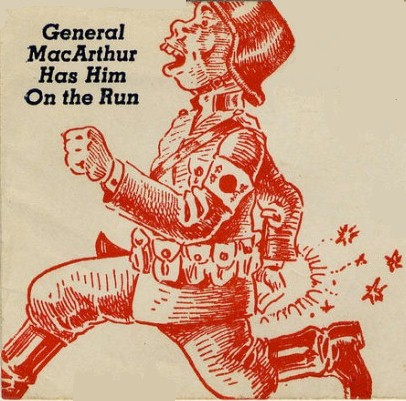
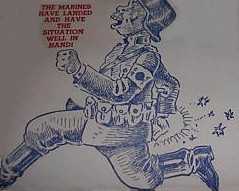
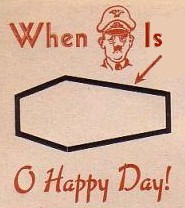
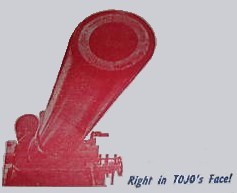
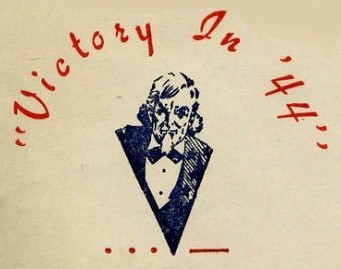

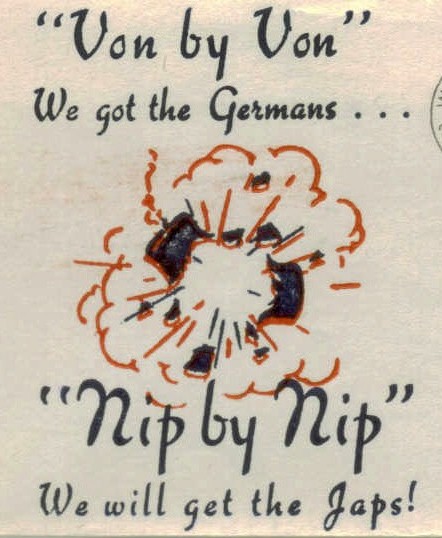
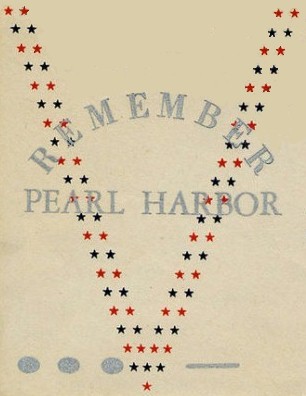
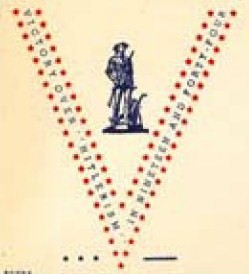
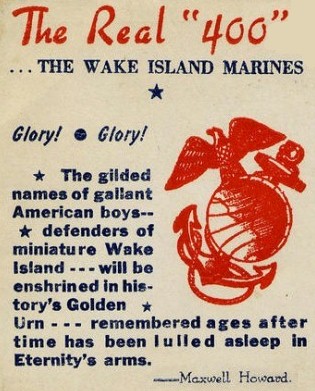
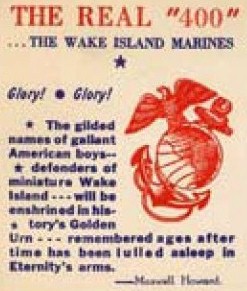
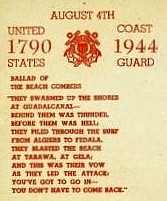
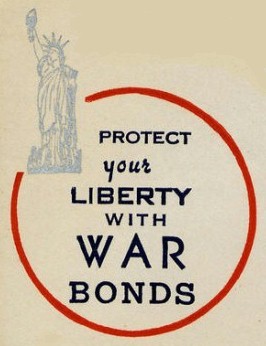
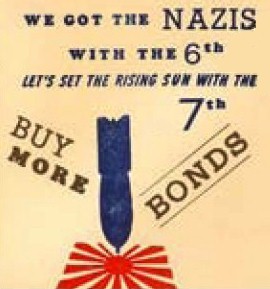
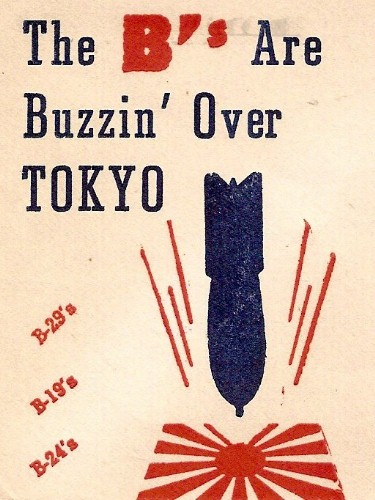
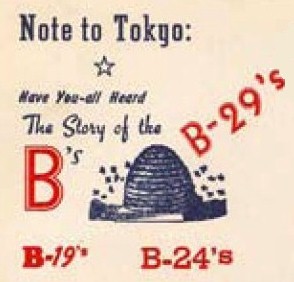
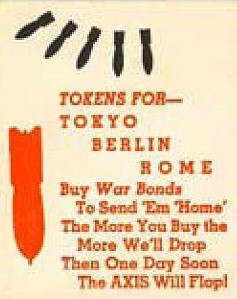
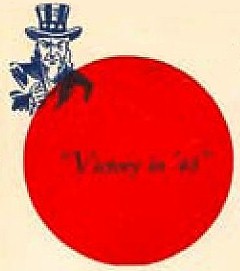
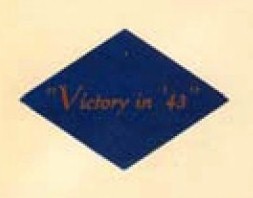
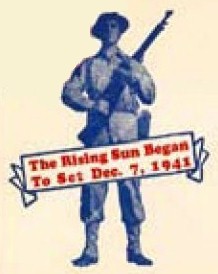
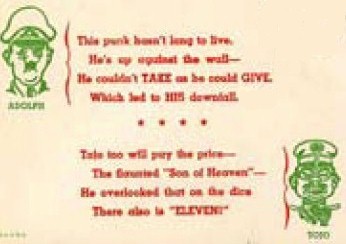
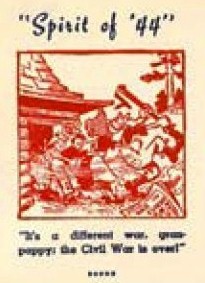
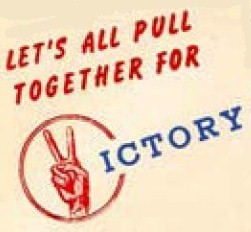
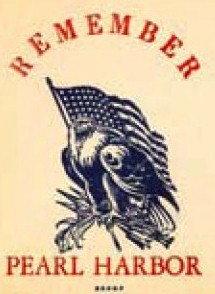
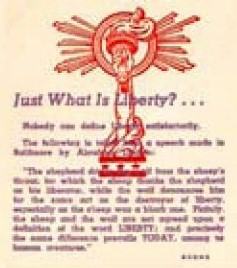
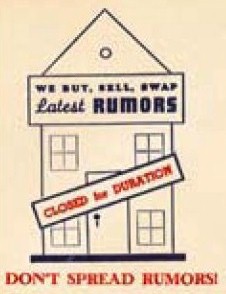
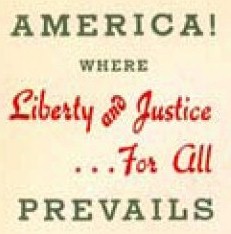
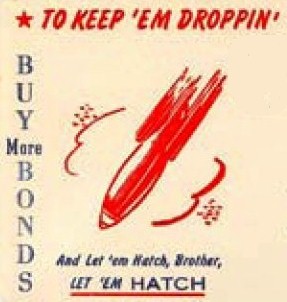
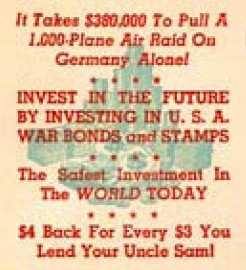
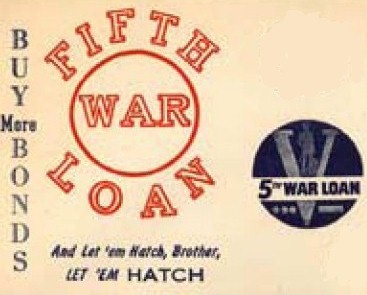

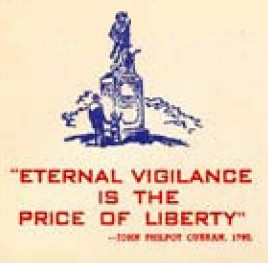
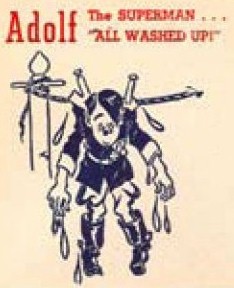
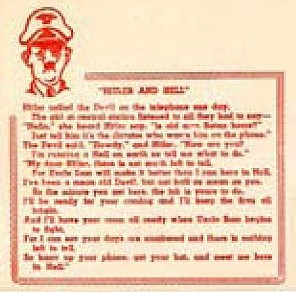
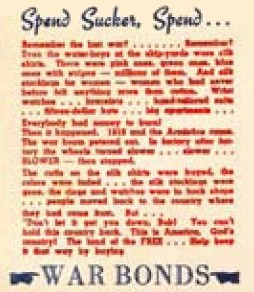


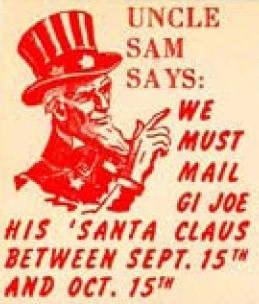
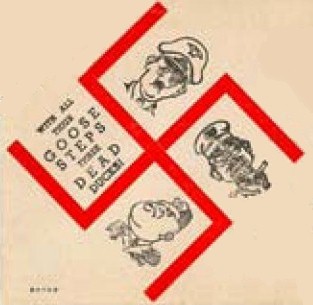
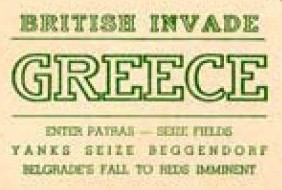
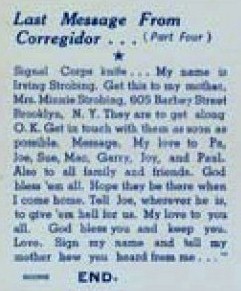
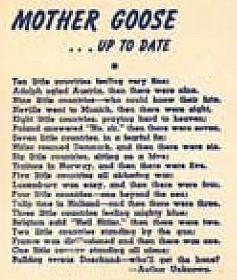
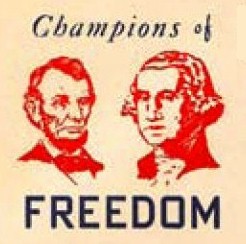
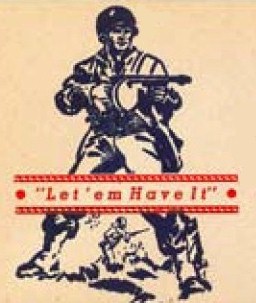
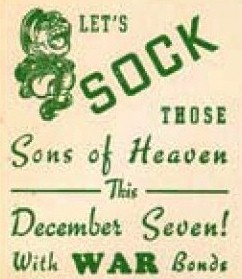
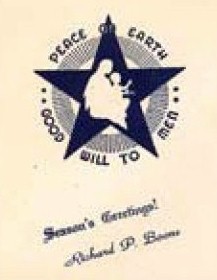
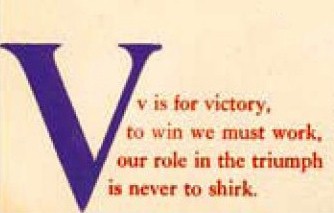
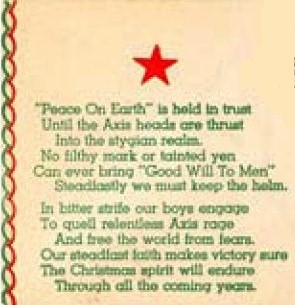
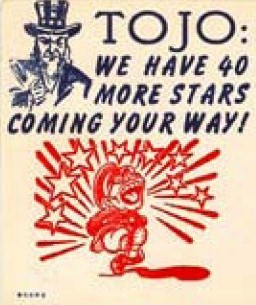
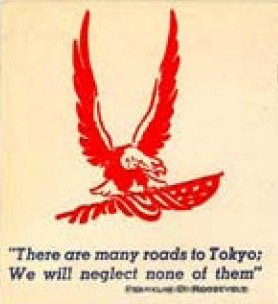
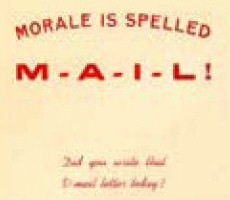
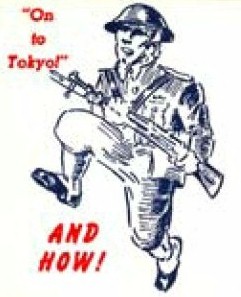

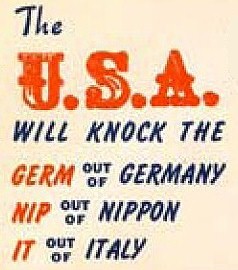
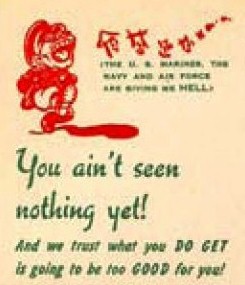
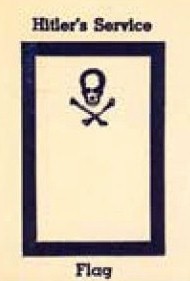
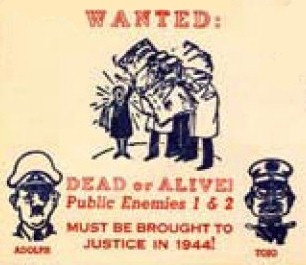
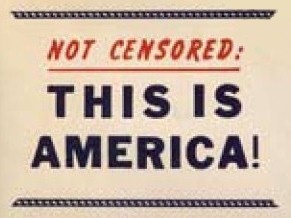
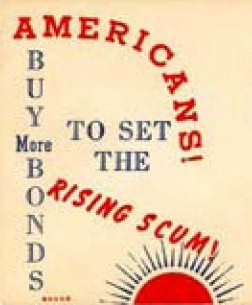
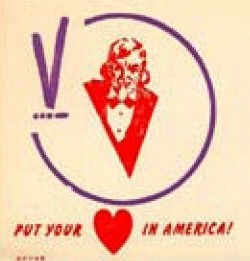
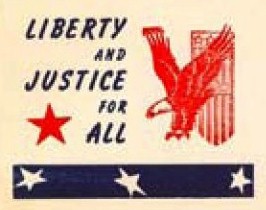
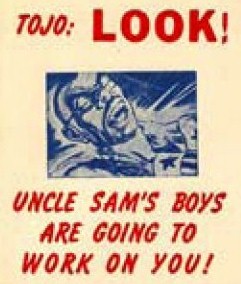
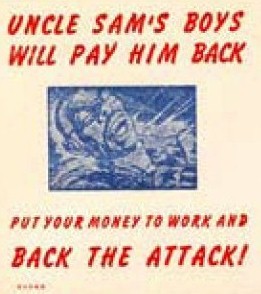
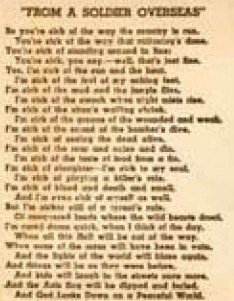
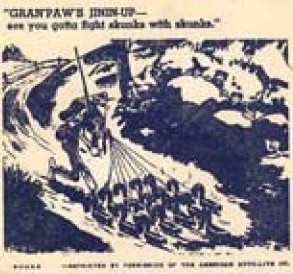
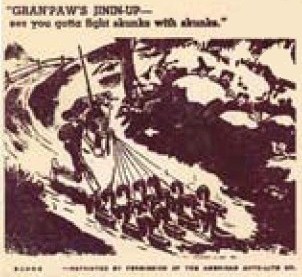
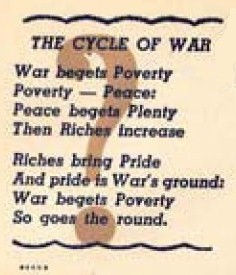
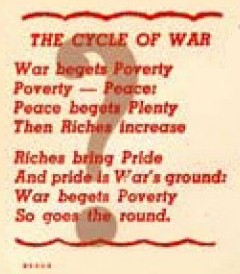
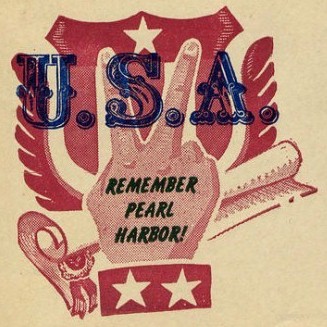
|
OO |
| VJ Day - "Victory in Japan" two weeks after the surrender of Japan on August 14, 1945. The formal Japanese signing of the surrender terms took place on board the battleship USS Missouri in Tokyo Bay on September 2, 1945 and President Harry Truman declared September 2nd to be VJ Day - "Victory in Japan." It was celebrated throughout the US and will be remembered by the Life Magazine photograph taken in Times Square New York City. |
||||
| 1945 |
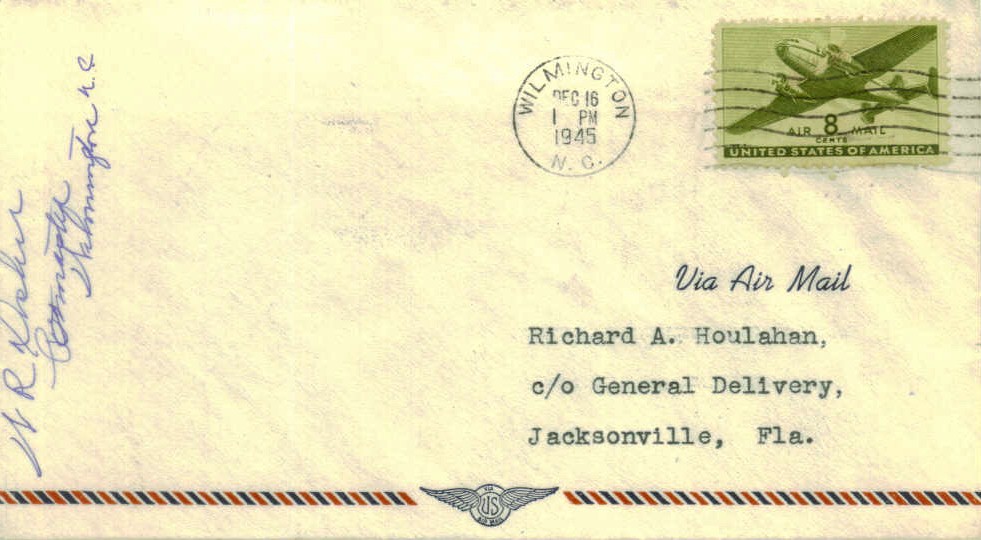
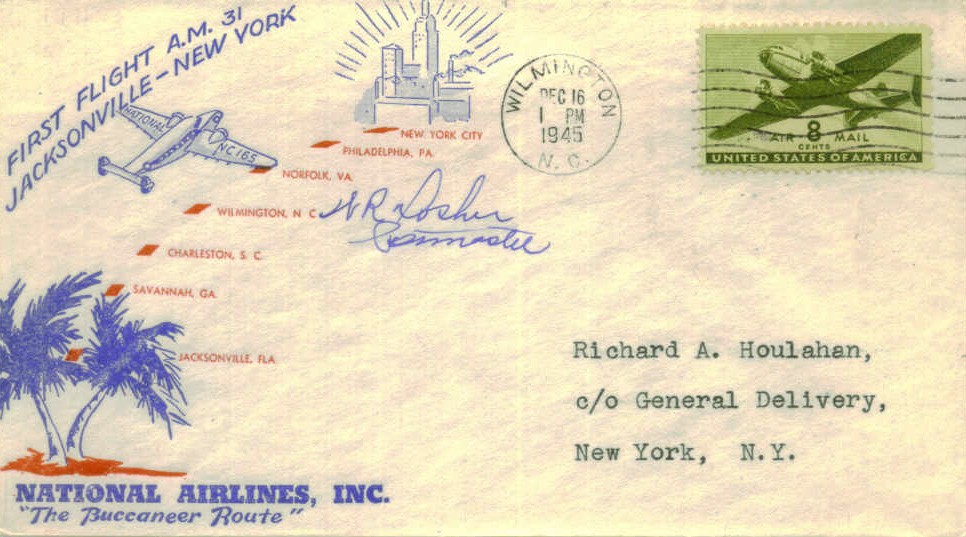
|
C-28 | Two airmail covers canceled in Wilmington NC on December 16, 1945 and flown on the first flight of National Airlines from Wilmington NC, the first flown north to New York City and the second flown south to Jacksonville FL. Both covers are signed by William R Dosher, Postmaster of Wilmington.
History: National Airlines Systems was founded in St Petersburg FL inaugurating flight service on October 15, 1934 between Saint Petersburg and Daytona Beach via Tampa, Lakeland and Orlando. National relocated it's general offices and principal base of operations from Saint Petersburg to Jacksonville in 1939. During WW-II National allocated a portion of its fleet to the Air Transport Command and operated Air Corps contract schools for pilots, mechanics, radio operators and navigators. At the end of WW-II, National expanded its flight routes along the east coast of the US from Jacksonville FL to New York City. Flying their Lockheed Lodestar aircraft, this route became know as National's "The Buccaneer Route." |
RP |
| 1946 |
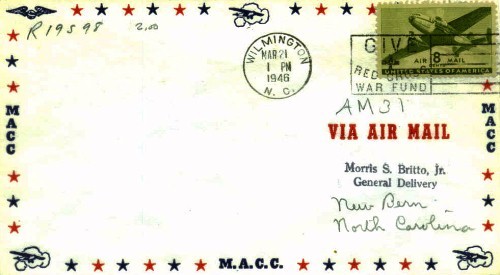
|
C-28 | An airmail cover canceled in Wilmington NC on March 21, 1946 and flown on the first flight of National Airlines when they inaugurated air line service to/from New Bern (located between Wilmington and Norfolk VA). Official PO Department Cachet for mail sent from New Bern NC. | TB |
| 1946 |
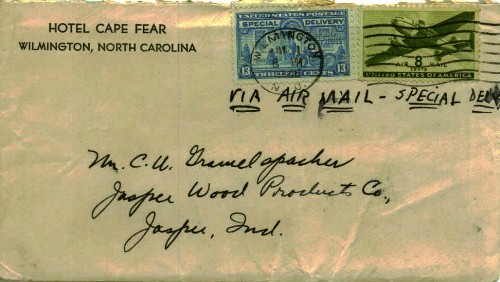
|
C-28 & E-17 |
An air mail special delivery cover canceled on May 11, 1946 sent from Wilmington to Jasper IN. The reverse side of the cover. The cover was sent from the Hotel Cape Fear and the letter it contained, written by George Sellers, spoke of the purchase of a wood production factory and his general observations of the logging industry and travel in North Carolina. History: The Hotel Cape Fear opened on January 10, 1925 and is the last surviving downtown hotel built before WW-II. It was designed by architect, G Lloyd Preacher. It is a nine-story structure on the northwestern corner of Second & Chestnut Streets. Its dining room was taken over by the US Army in 1942 for one year and used as a Women's Army Corps (WAC) mess hall. In the 1980's it was renovated and converted from a hotel into apartments for senior citizens. |
TB |
| 1947 |
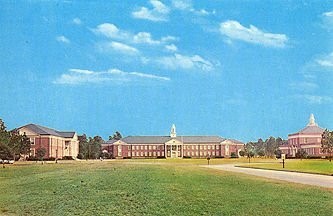
|
--- | A post card (circa 1960) of Wilmington College. History: After the end of WW-II there was added emphasis for continuing education. Evening classes began in 1946 at New Hanover Highschool and Wilmington College Center was born. As enrollment increased, the College Center moved into the Bear building. Soon thereafter Wilmington College, under the New Hanover County Board of Education, opened its doors on September 4, 1947 as a junior college offering freshman-level courses to 250 students. The institution earned accreditation from the North Carolina College Conference in 1948 when it became a member of the American Association of Junior Colleges. Further accreditation came in 1952 when the institution was so-honored by the Southern Association of Colleges and Schools. In 1958 Wilmington College was placed under the Community College Act of North Carolina thereby passing control from the New Hanover County Board of Education to a board of trustees. The college was now state-supported and under the supervision of the North Carolina Board of Higher Education. Wilmington College became a senior college on July 1, 1963 when the North Carolina General Assembly passed legislation allowing the school to offer a four-year curriculum and award bachelor's degrees. Six years later on July 1, 1969 the name of the school was changed to the University of North Carolina at Wilmington, making UNCW the fifth campus of the University of North Carolina system. On August 22, 1977 UNCW was authorized to offer its first graduate programs at the master's level. Visit the University of North Carolina - Wilmington. |
OO |
| 1948 |
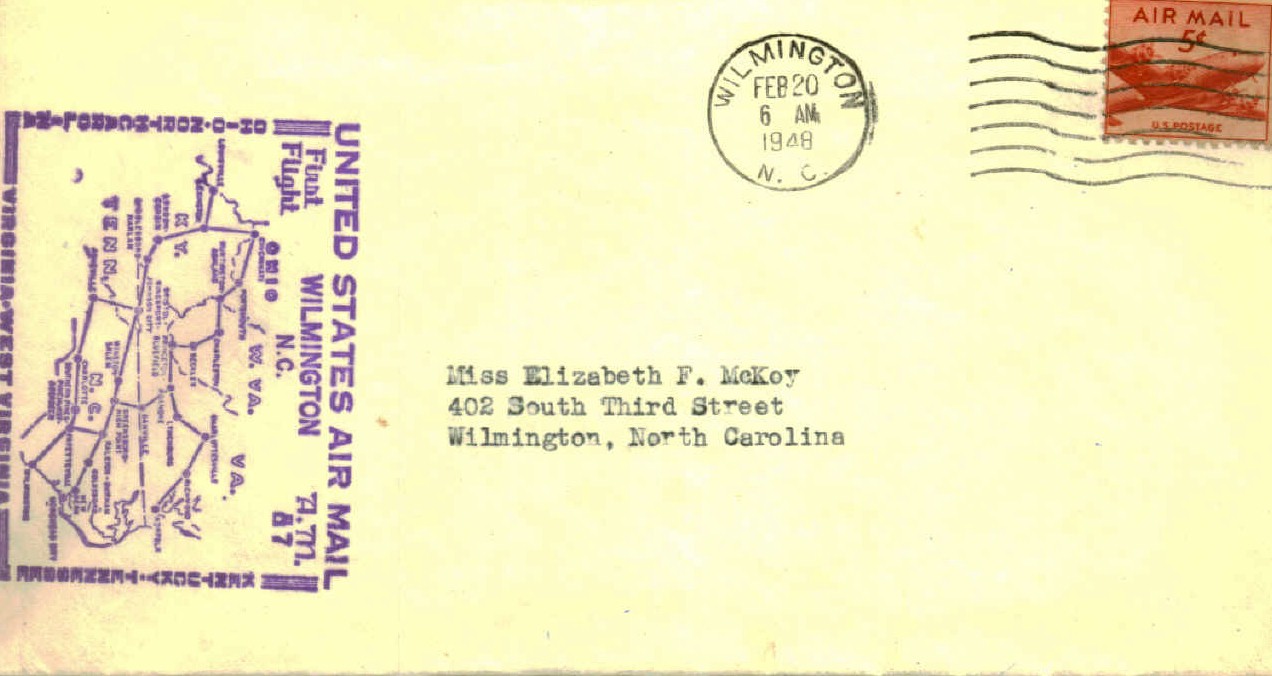
|
C-33 | An airmail cover canceled on February 20, 1948 in Wilmington NC and flown on the first flight of Piedmont Airlines when they inaugurated mid-south air line service. Route map cachet. History: Thomas H. Davis founded Piedmont Airlines. On February 20, 1948 Piedmont inaugurated flight service between Wilmington and Cincinnati OH. It made intermediate stops in Aberdeen, Pinehurst, Southern Pines, Charlotte and Asheville NC, Bristol-Kingsport-Johnson City TN and Lexington, KY. Piedmont grew from the smallest of 17 local and trunk airlines to become the 6th largest airline in the US in terms of passengers carried, flying over 200 jet aircraft from Los Angeles to London. Piedmont expanded its route system and profitability only to become a candidate for a potential buyout. In August 1989 Piedmont Airlines was absorbed by USAir. |
FO |
| 1948 |
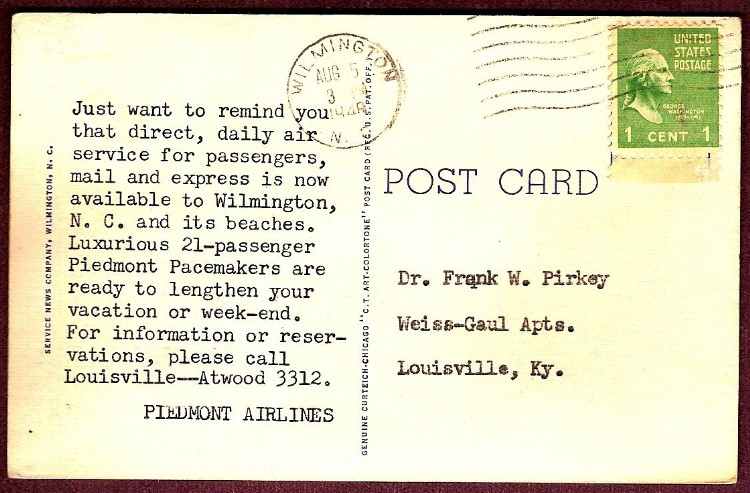
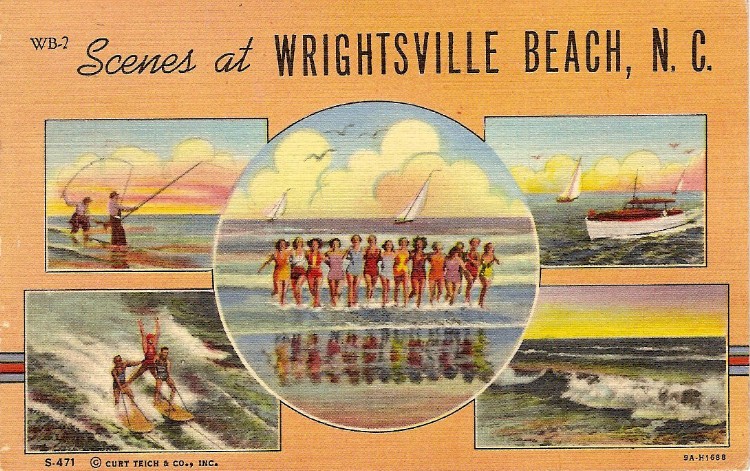
|
804 | A post card canceled on August 5, 1948 in Wilmington NC with a special reminder message of the new Piedmont air service between Wilmington Airport and Kentucky. History: Piedmont Airlines used the 21 passenger DC-3 known as the Pacemaker. A DC-3 painted in the representative markings of Piedmont is operated by the Carolinas Aviation Museum. It continues to fly to air shows and has been used in several movies. |
JJ |
| Korean War - On June 25, 1950 North Korea invaded South Korea bringing about a United Nations "police action" against North Korea. This produced heavy military and naval involvements of the United States. The US and other involved UN countries scrambled to contain North Korea's aggression in what was seen as a global military challenge from the Communist world. China intervened openly and the Soviet Union not-so-openly on the side of their Communist neighbor. On July 27, 1953 with a new USSR regime and the blunting of a final Communist offensive, negotiations concluded and fighting ended. The Cold War, warmed up by the Korean experience, would continue for nearly four more decades. |
||||
| 1950 |
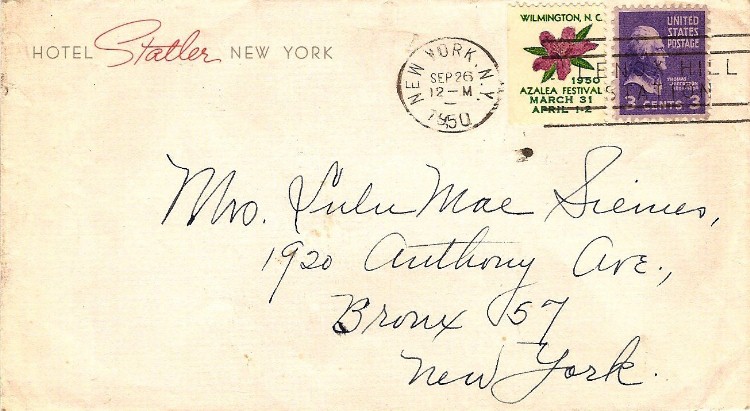
|
807 | A cover canceled on September 26, 1950 at New York NY
with a special cinderalla stamp commemorating the Azalea Festival in Wilmington NC. History: Wilmington has been the home of the annual springtime "North Carolina Azalea Festival" which first began in 1948. The Festival is a celebration of Wilmington's exceptional azalea gardens showcasing the brilliant floral displays with which southeastern North Carolina greets the spring. Additionally, the Festival celebrates the rich history, artwork and culture of Wilmington. It is usually celebrated over five days of entertainment that now includes a parade, street fair, circus, concerts, pageantry and all that is Southern. The Festival is substantially sponsored by four major organizations including GE-Wilmington, Neuwirth Chrysler-Jeep, Progress Energy and the Wachovia Bank. This year the 61st Annual "North Carolina Azalea Festival" will be held April 9-13, 2008 in the greater Wilmington area. |
JJ |
| 1952 |
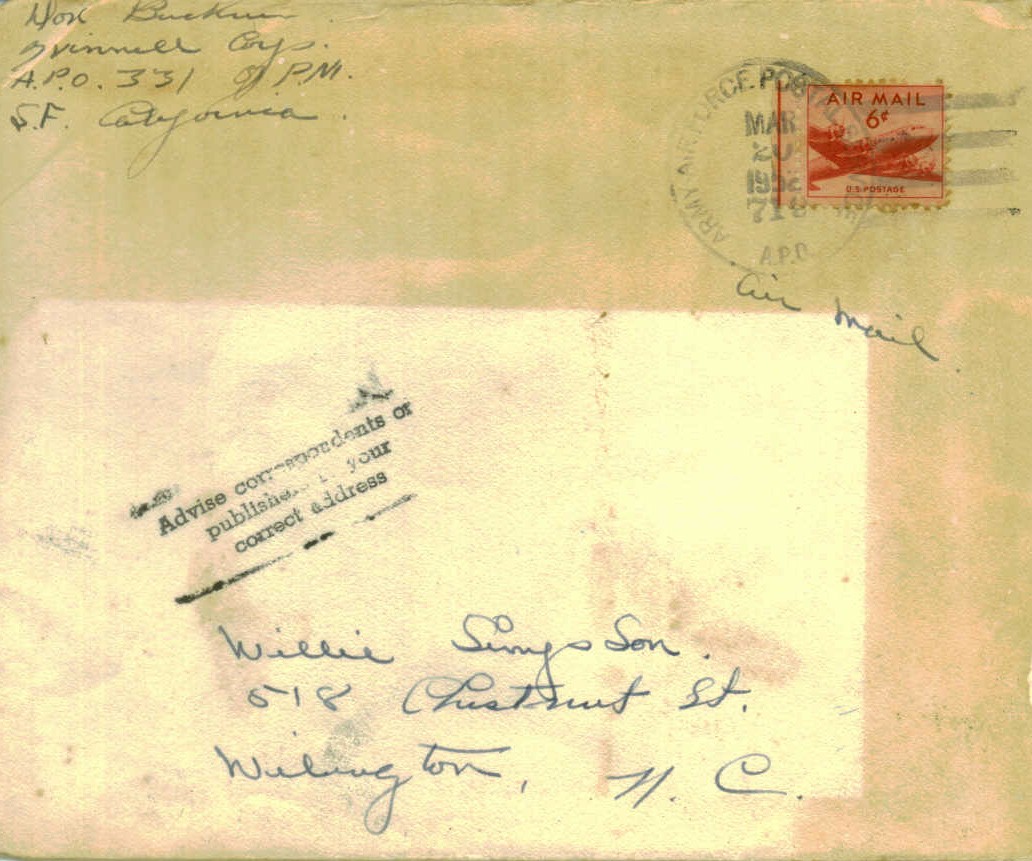
|
C-39 | An airmail cover sent by Don Buckner (Vinnell Corp) from APO 331 (Okinawa Ryukyu Islands) canceled on Mar 20, 1952 to Millie Simpson in Wilmington NC. History: The US labeled Okinawa as the "Keystone of the Pacific" since Taipei, Shanghai, Hong Kong, Seoul, Manila and Tokyo all lie within a 1,000 mile radius of the Ryukyuan Islands. The US military presence in Japan and on Okinawa began at the end of WW-II. Although the US occupation in Japan ended in 1952, Okinawa legally became a possession of the US and the US administration of Okinawa continued until 1972. One of the important US-Okinawan operations was its support in the defense of South Korea in the 1950-53 Korean War. The Vinnell Corporation which began as a southern California construction firm in 1931 built a reputation on civilian projects including portions of the Los Angeles CA freeway system, the Grand Coulee Dam WA and NY Dodger Stadium. By the end of WW-II, Vinnell initiated military contracts constructing US military airfields in Japan, Okinawa and Taiwan. |
RP |
| 1952 |
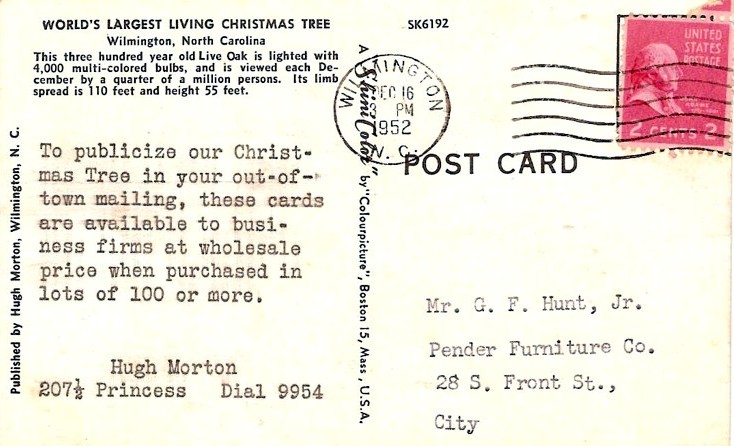
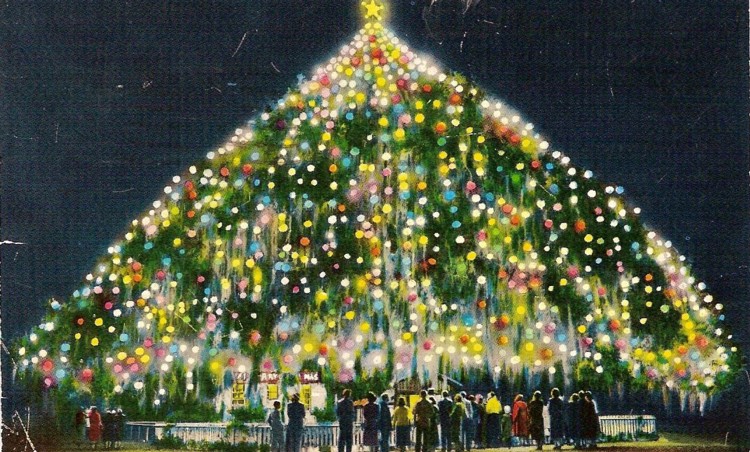
|
806 | A post card canceled on December 16, 1952 in Wilmington NC with a special message from Hugh MacRae Morton to publicize the "World's Largest Living Christmas Tree" growing in Wilmington. The post card was published by Morton with a picture taken by him. History: Hugh MacRae Morton was born in Wilmington on February 19, 1921 pursuing a career as a photographer and nature conservationist. He authored two books of his photography, Hugh Morton's North Carolina (2003) and Hugh Morton, North Carolina Photographer (2006). Morton served as combat newsreel cameraman in WW-II in the Pacific Theater where he received the Purple Heart and Bronze Star. He became the president of the 1st North Carolina Azalea Festival in Wilmington in 1948. He was a member of the NC Board of Conservation & Development from 1951 through 1961 and served on the board as chairman of the State Advertising Committee and vice-chairman of the State Parks Committee. In 1952 Morton inherited Grandfather Mountain from his grandfather and namesake, Hugh MacRae. He worked to protect North Carolina’s tourist sites including the Cape Hatteras Lighthouse and the sand dunes at Jockey’s Ridge. For this, he received numerous awards including one from the White House for his photography and environmental conservation efforts. He helped save the battleship USS North Carolina and was the first chairman of the battleship commission in 1961. In the 1972 race for NC’s governor, Morton ran unsuccessfully against James Holshouser who became the first Republican governor of NC in the 20th century. Morton was the first recipient of the Charles Kuralt Award (2000) for bringing exceptional, positive national attention to the state of North Carolina by the NC Travel Industry Association. Hugh Morton died at his home near Grandfather Moutain in Linville NC on June 1, 2006. |
RP |
| 1956 |
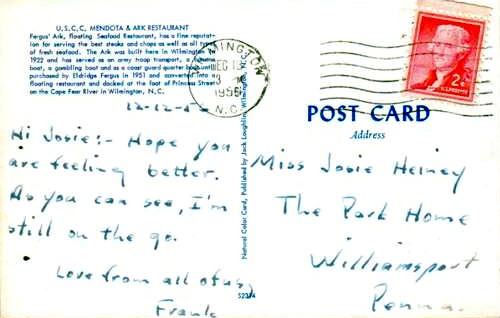
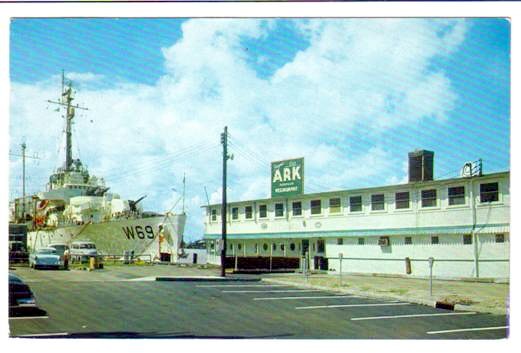
|
1033 | A post card canceled in Wilmington NC on December 13, 1956 showing the Coast Guard "Cutter Mendota" docked in Wilmington NC." History: The USCGC Mendota (WHEC-69) was an Owasco class high endurance cutter (patrol gunboat) built by the Coast Guard Yard at Curtis Bay MD for WW-II service. The 255 foot vessel was commissioned on June 2, 1945, a few weeks too late for any combat action in WW-II. The first duty station for the Mendota was Boston MA where she was homeported from April 1946 to January 1947. She was used for law enforcement, ocean station and search and rescue operations. She was then transferred to Wilmington NC where she remained until February 29, 1972. From her Wilmington homeport, the Mendota rotated with other Coast Guard Cutters supporting International Ice Patrol operations. She served on patrol at Ocean Stations Charlie and Echo in the Atlantic where she supported weather and rescue duties. Other accomplishments included disabled vessel towing, medical emergencies and evacuations (medivac), sea escorts, search and rescues, hurricane support, reserve cruises and official inter country visits. On January 27, 1969 the Mendota departed Wilmington NC for a tour of duty off the coast of Viet Nam. She participated in market-time patrols, detecting, inspecting and boarding suspect vessels. Other Viet Nam operations included participation in Special Operation Sealord, Navy Seal missions and Operation Silver Mace. The Mendota provided troop transport, operational base activity and became a rest-stop for mercenaries. Between March and October 1969 she steamed close to thirty thousand miles while remaining underway over 70% of the time. The Mendota conducted naval gunfire support missions expending over 2, 500 rounds of ammunition, over 700 mortar rounds and over 30,000 rounds of machine gun firings. Additionally, the Mendota participated in humanitarian missions and medical care of the civilian population (Medcaps). She served as the mother-ship supporting US Navy Swift Boats providing logistic and medical support. The Mendota returned to her Wilmington NC homeport on November 27, 1969 after traveling over 60,000 miles, transiting the Panama Canal in both directions with visits to ports in Hawaii, Guam, Taiwan, Thailand, Viet Nam, Hong Kong and the Philippines. She was decommissioned on February 29, 1972, recommissioned as a Coast Guard off-shore law enforcement vessel homeported in New Bedford MA and permanently decommissioned on November 1, 1973. After being mothballed for several years, the Mendota was sold to American Smelting Company and was scrapped in 1978. |
JJ |
| 1962 |
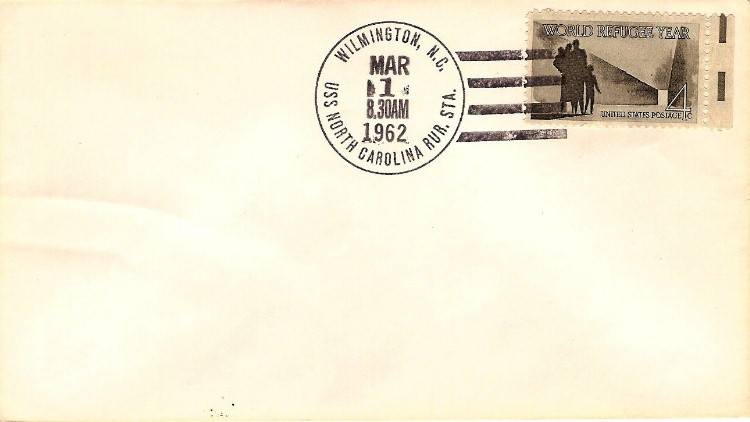
|
1149 | A cover sent from the USS North Carolina (Rural Postal Station) on March 1, 1962. For details on the USS North Carolina see the 1941 commissioning cover above. Visit the USS North Carolina Battleship Memorial. |
JJ |
| 1963 |
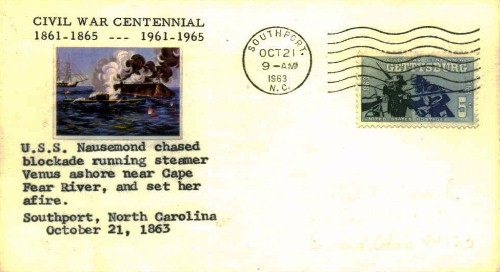
|
1180 | A cover canceled on October 21, 1963 at Southport NC commemorating the 100th anniversary of the battle between the north's USS Nansemond and the south's blockade-runner, the "Venus." History: Cape Fear had two channels to the ocean. The Confederates built Fort Fisher to protect ships entering and leaving the harbor. Fort Fisher kept the Northern Union fleet far enough from the shore to allow blockade runners to slip past. Once the cargoes were discharged in Wilmington, the city's rail links could move the supplies to other parts of the Confederacy. The blockade-runner, "Venus" was a side wheeler schooner with two masts and square sails capable of carrying a cargo of 700 tons. The USS Nansemond was a side-wheel steamer built at Williamsburg NY in 1862. It was purchased by the US Navy at New York City on August 18, 1863 and commissioned the next day in Baltimore under the command of Lt. Roswell H. Lamson. While on patrol off the North Carolina coast, the USS Nansemond cited the "Venus" on October 21, 1863 and gave chase. The Nansemond fired four shots causing the "Venus" to take on water. The "Venus" was forced ashore near the mouth of the Cape Fear River. The next morning Lt Lamson ordered his crew to re-float the "Venus" and failing to do so, set it a fire. |
TB |
| 1964 |
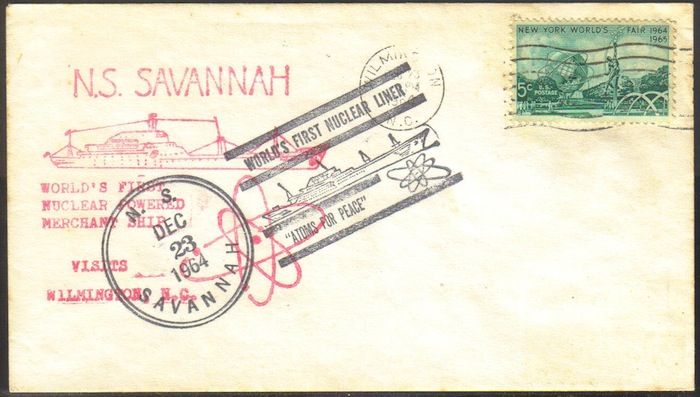
|
1244 | A cover canceled on December 23, 1964 in Wilmington
commemorating the visit to Wilmington NC of the world's
first nuclear powered merchant ship, the
NS SAVANNAH. History: The NS Savannah was launched on July 21, 1959 to become the first nuclear-powered cargo-passenger ship. She was built as part of President Eisenhower’s "Atoms for Peace" initiative. Congress authorized the building of the Savannah as a joint project of the Atomic Energy Commission, the Maritime Administration (MARAD) and the Department of Commerce. Designed to be visually impressive, the Savannah looked more like a luxury yacht than a bulk cargo vessel. She performed well at sea, her safety record was impressive and her fuel economy was unsurpassed. She became a demonstration of the technical feasibility of nuclear propulsion for merchant ships but was never commercially competitive and this economic inefficiency destined her to a short career. The Savannah’s maiden voyage was from Camden NJ to Savannah GA in August 1962. This was followed by a series of demonstration voyages which brought her to Wilmington NC on December 23, 1964. After that MARAD leased the Savannah to American Export Lines where she began experimental commercial revenue operations through 1971 steaming in excess of 450,000 nautical miles visiting more than 70 foreign and domestic ports. MARAD decommissioned her in 1972 to save costs. She went into storage and in 1981 went on display at the Patriots Point Naval and Maritime Museum near Mount Pleasant SC. Since the Savannah is historically significant she has been designated a "National Historic Landmark." On May 8, 2008 she arrived in Baltimore MD to undergo nuclear decommissioning, decontamination and radiological cleanup before being converted into a museum. |
JJ |
| 1965 |
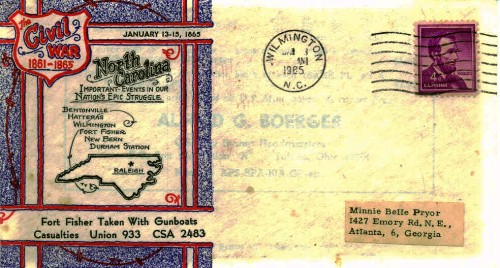
|
1036 | A cover sent on January 13, 1965 from Wilmington to
Atlanta GA. It commemorates the capture of Fort Fisher, the last battle of the Civit War. History: Wilmington remained open until the last months of the Civil War. Finally, in January 1865, the Northern Union navy staged a massive bombardment and assault of Fort Fisher. Fort Fisher fell on January 15, 1865, followed by Wilmington a few weeks later. |
TB |
| 1965 |
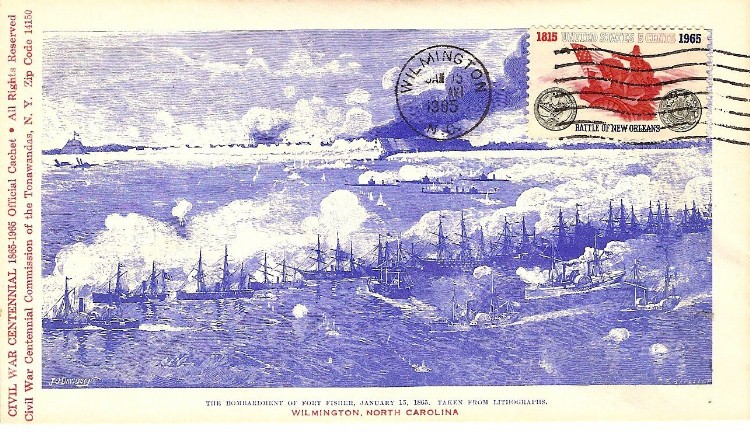
|
1261 | A cover sent from Wilmington NC on January 15, 1965 commemorating the 100th anniversary of the fall of Fort Fisher. Visit the USS North Carolina Battleship Memorial. |
JJ |
| 1965 |
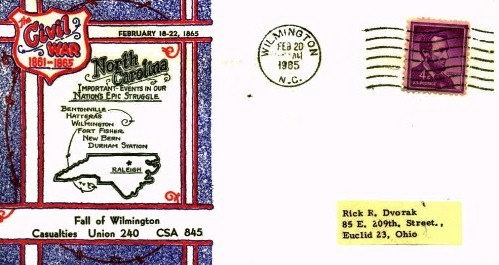
|
1036 | A cover sent on February 20, 1965
from Wilmington to Euclid OH. It commemorates the fall of Wilmington and the end of the Civit War. History: Wilmington remained open until the last months of the Civil War. Finally, in January 1865, the Northern Union navy staged a massive bombardment and assault of Fort Fisher. Fort Fisher fell on January 15, 1865, followed by Wilmington a few weeks later on February 22, 1865. |
TB |
| 1965 1966 |
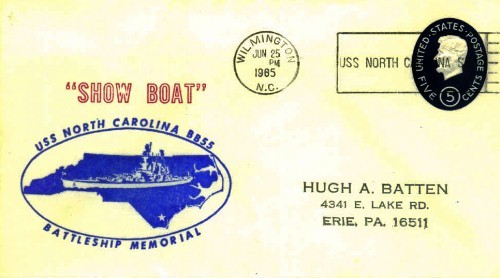
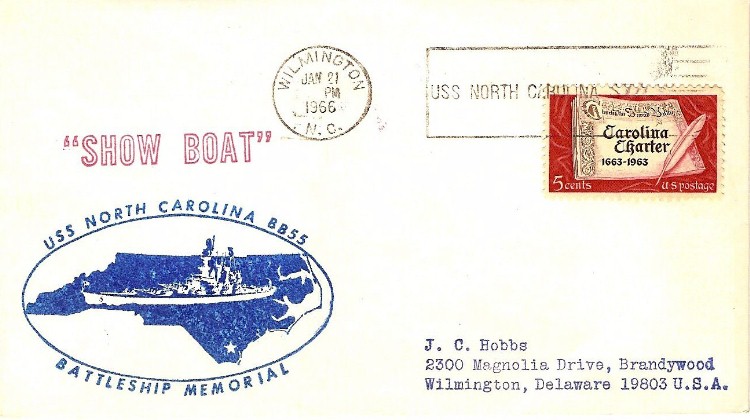
|
U544 1230 |
The top cover was sent from the USS North Carolina
on June 25, 1965 to Erie PA. The bottom cover was sent from the USS North Carolina on January 21, 1966 to Wilmington
DE. Both covers commemorate the "Show Boat" theme for ship visitors. For details on the USS North Carolina see the 1941 commissioning cover above. Visit the USS North Carolina Battleship Memorial. |
TB JJ |
| 1970 |
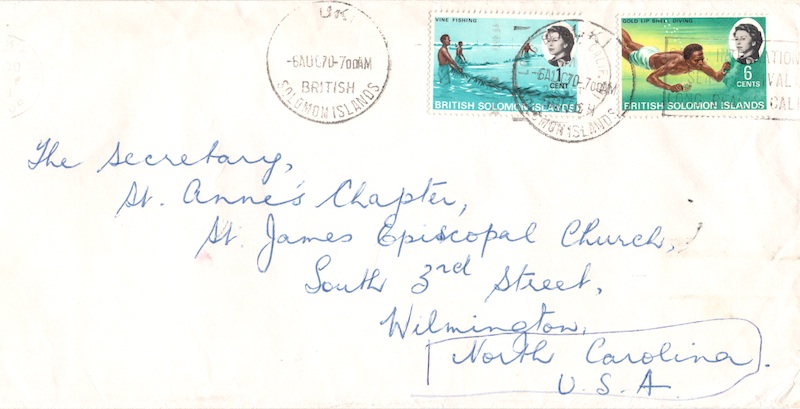
|
SI 180 184 |
A cover sent on August 6, 1970 from the British Soloman Islands to the Saint James Episcopal Church in Wilmington. This cover was mistakenly first sent to Wilmington CA. History: Saint James Parish was established in November 1729 when the General Assembly of the Colony of Carolina approved legislation stating, "The Southernmost Boundary of the Province shall be and is hereby appointed a separate and district parish by the name of Saint James." The first Saint James Church building was completed in 1751. In January 1781 Wilmington was occupied by British forces commanded by Major James Henry Craig. Craig was later joined by Lord Cornwallis before Cornwallis left Wilmington on his fateful march to Yorktown VA where he surrendered. While in Wilmington Saint James Church had been seized by British troops who converted it into a stable and riding school. In the 1830’s with the financial help of Dr Thomas Henry Wright, Saint James Parish built the Lebanon Chapel near Wrightsville Beach. Construction of the existing Saint James Episcopal Church in downtown Wilmington began in 1839. Wilmington remained open until the last months of the Civil War. In January 1865, the Northern Union navy staged a massive bombardment and assault of Fort Fisher. Fort Fisher fell on January 15, 1865, followed by the surrender of Wilmington on February 22, 1865. Saint James Church was seized again and used as a Union hospital. Over the years Saint James Church expanded with the addition of the Parish House in 1902, Milton Hall constructed in 1951 and the MacRae House acquired in 1955. |
AV |
| 1971 |
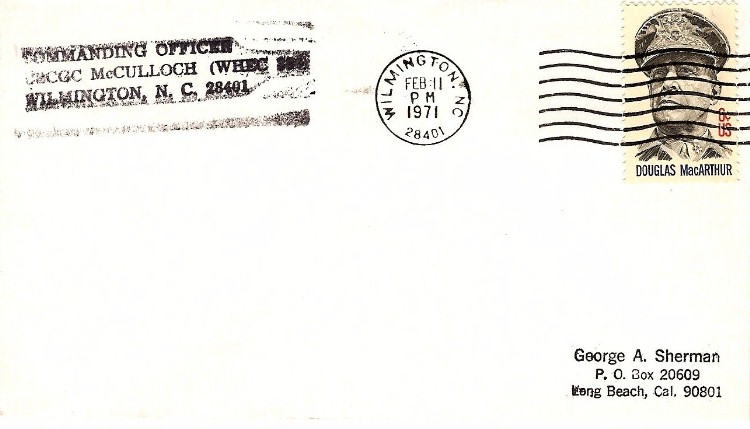
|
1424 | A cover canceled on February 11, 1971 at Wilmington NC sent by the Commanding Officer of the US Coast Guard Cutter, USCGC McCulloch (WHEC-386) which was stationed at Wilmington NC. History: The McCulloch began life as a United States Navy motor torpedo boat tender. She was launched on July 10, 1943 and commissioned into the US Navy on May 17, 1944. During WW-II she served in the New Guinea campaign, the Philippines campaign, and the campaign in Borneo and performed postwar service in Borneo. She was decommissioned from the Navy on May 10, 1946 at Boston MA. The McCulloch was then transferred to the United States Coast Guard on May 27, 1946 and underwent conversion for service as a weather reporting ship. The Coast Guard commissioned her as USCGC McCulloch (WAVP-386) on November 25, 1946. Her first home port was Boston MA where she remained until July 1966. In late 1965 the McCulloch was assigned to patrol the Florida Strait and rescue Cuban refugees during the Cuban Exodus. On May 1, 1966 the McCulloch was reclassified as a high endurance cutter and redesignated WHEC-386. In July 1966 she was stationed in Wilmington NC. Her primary duty was in the Atlantic Ocean gathering meteorological data as a floating oceanographic laboratory, a search-and-rescue ship for downed aircraft and vessels in distress and engaged in law enforcement operations. On June 17, 1970 the McCulloch helped fight a fire aboard the merchant ship Tsui Yung in Wilmington and on June 21, 1972 was re-assigned and departed her Wilmington home port for the US Navy base at Apra Harbor Guam and shortly thereafter to South Vietnam. In South Vietnam the McCulloch was commissioned into the Republic of Vietnam Navy as patrol vessel RVNS Ngo Kuyen (HQ-17). When South Vietnam collapsed at the end of the Vietnam War in April 1975 the Ngo Kuyen fled to the Philippines. She was transferred to the Republic of the Philippines on April 5, 1976 where the Philippine Navy commissioned her as the patrol vessel BRP Gregorio del Pilar (PF-8). She was decommissioned and scrapped in the early 1990's. |
JJ |
| (> 1859) Page 1 | (1860-1897) Page 2 | (1898-1916) Page 3 | (1917-1941) Page 4 | (1942-1971) Page 5 | (1972 >) Page 6 |